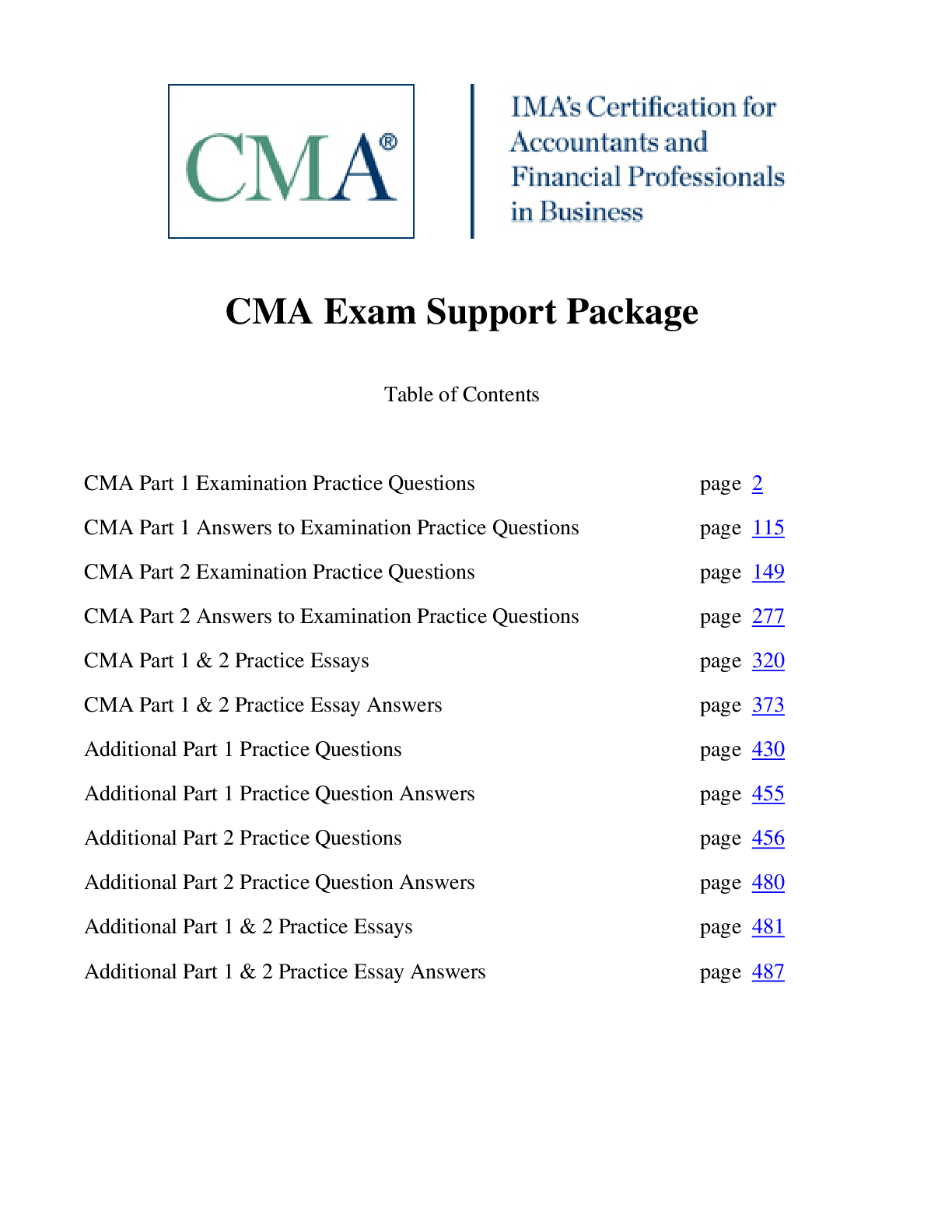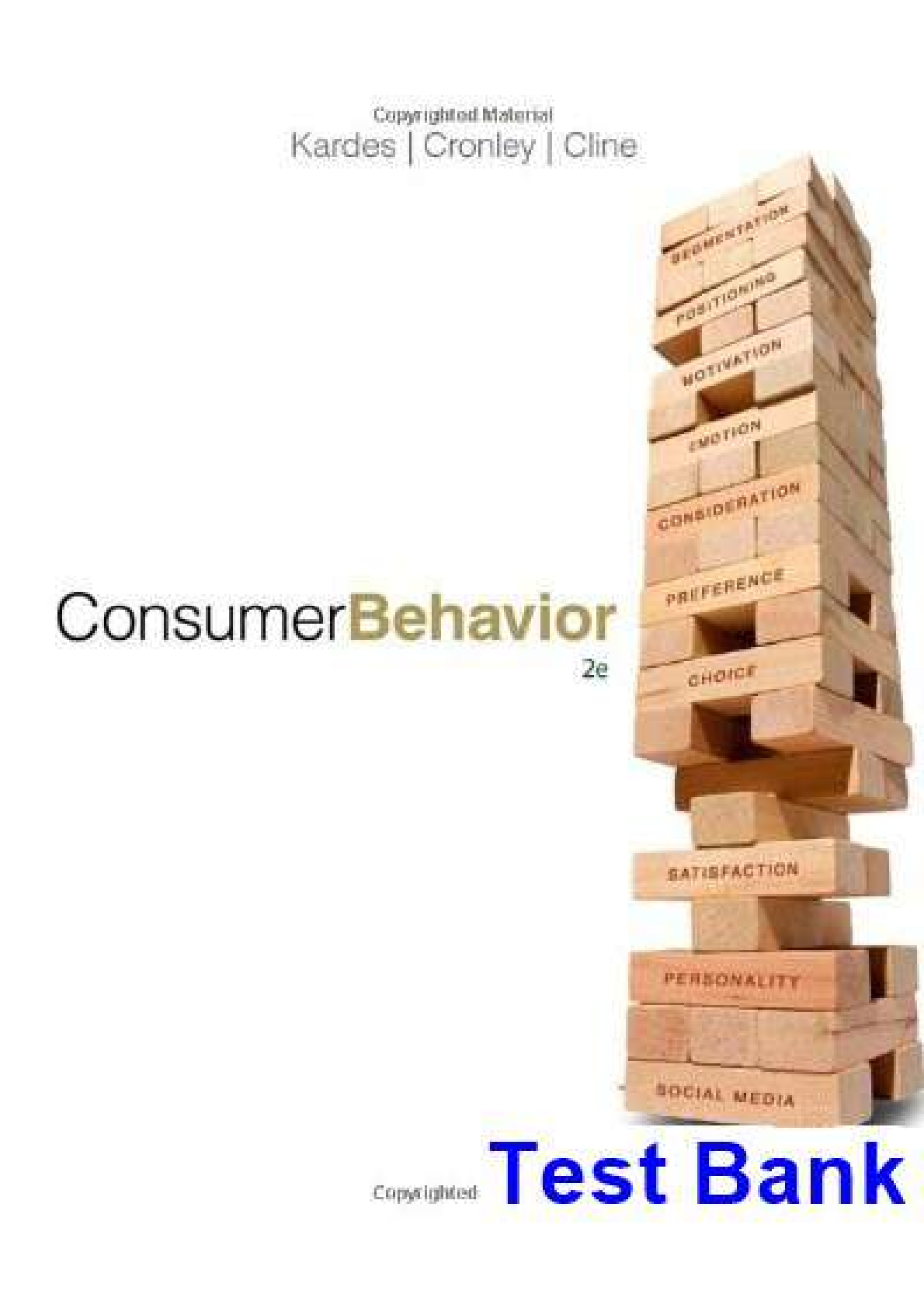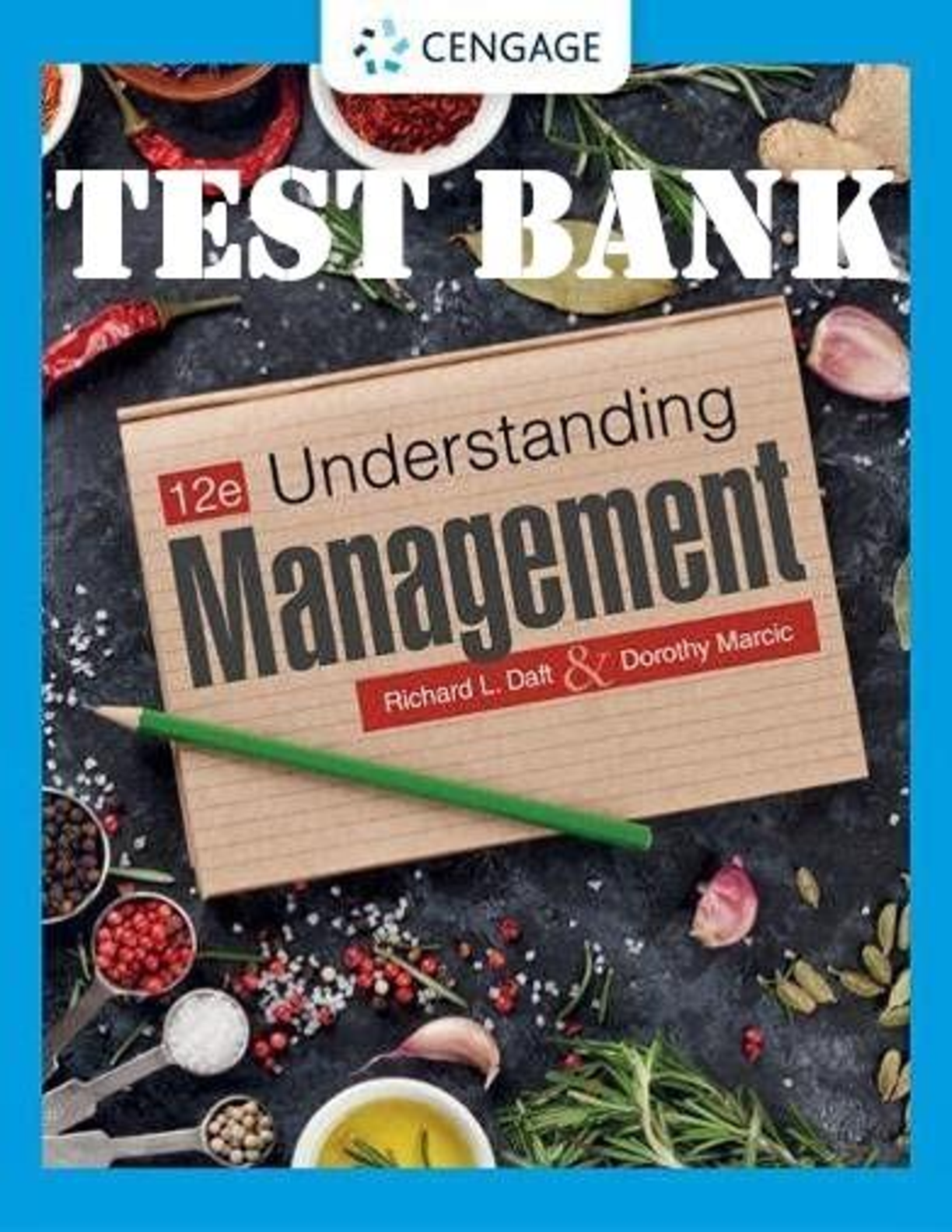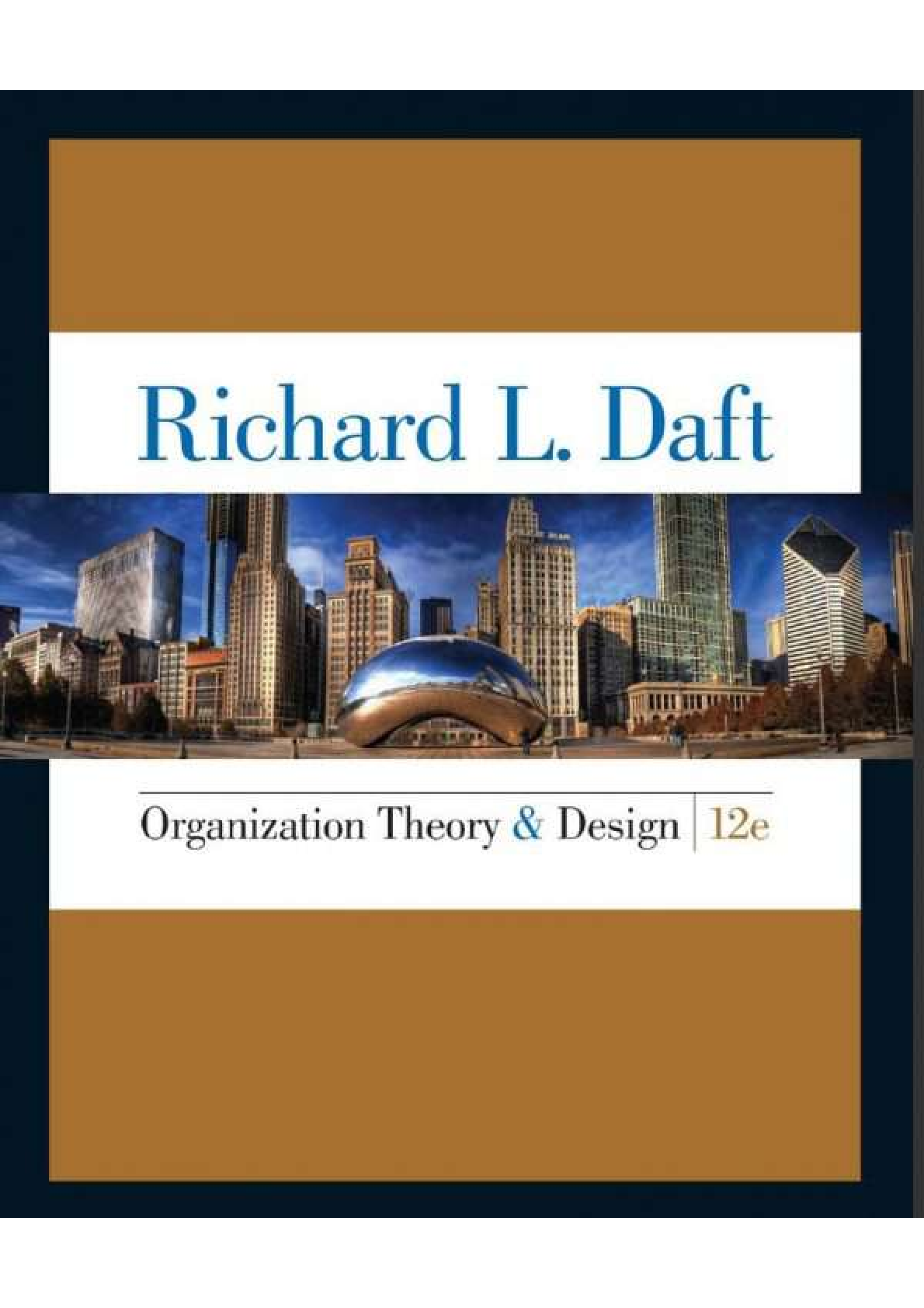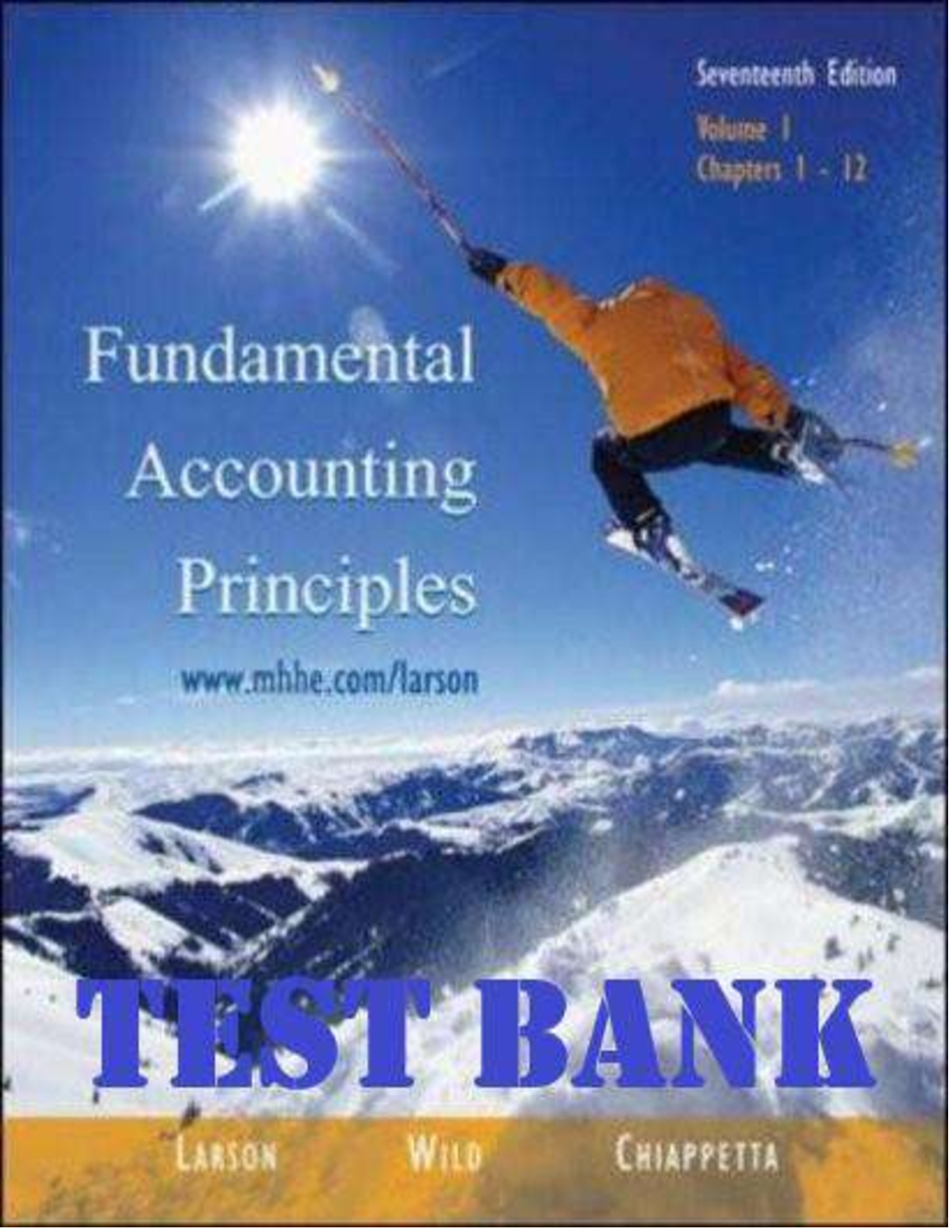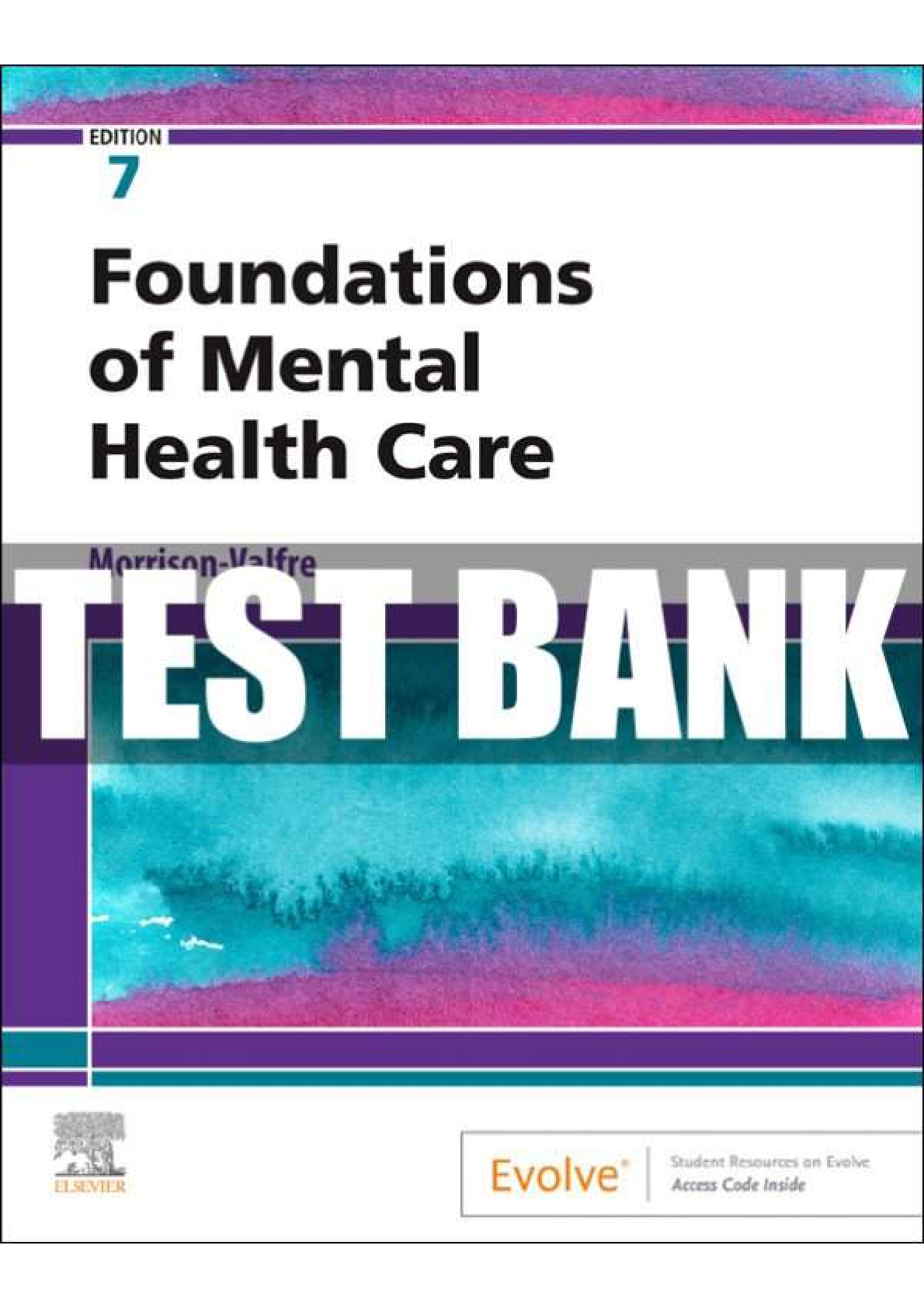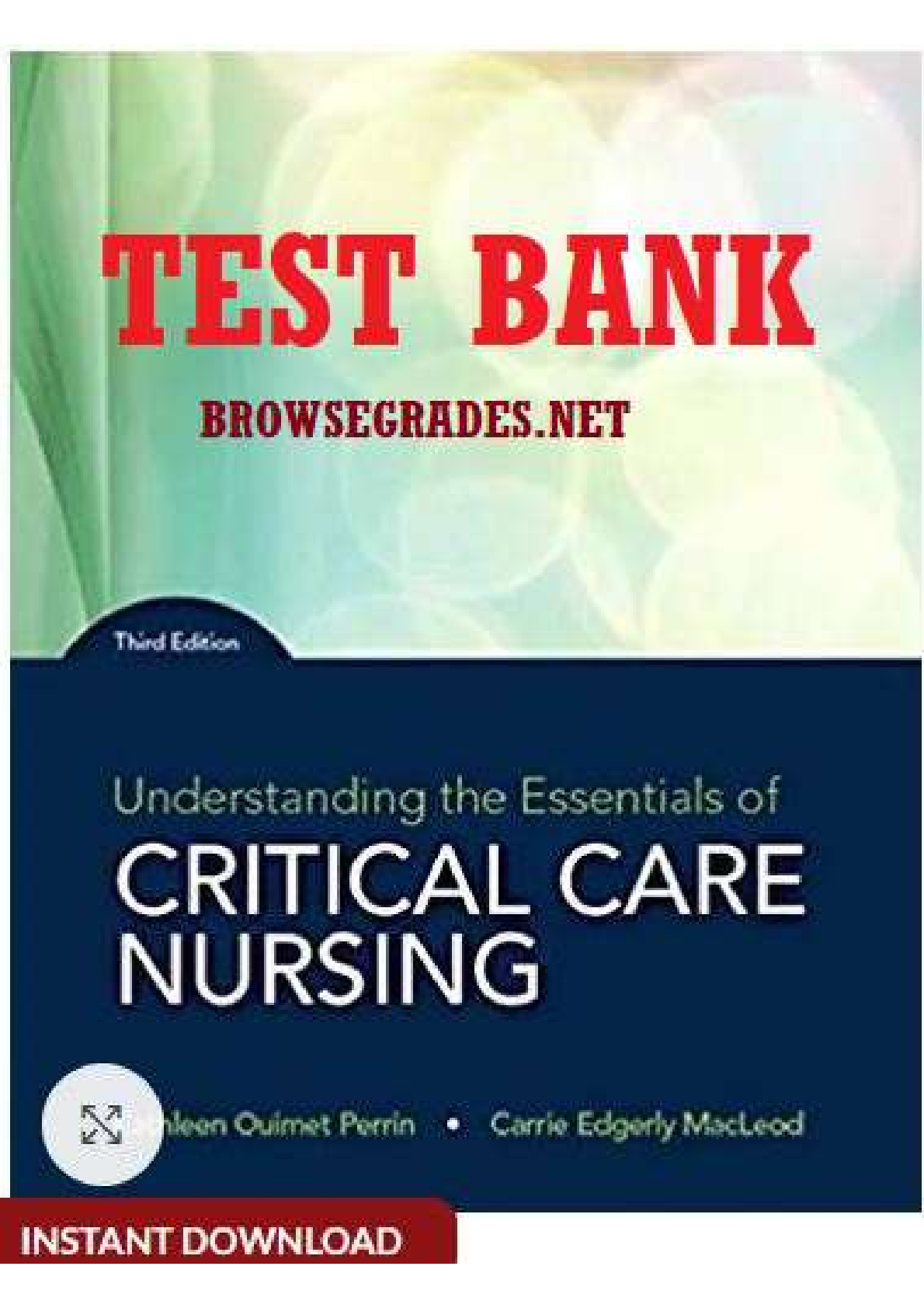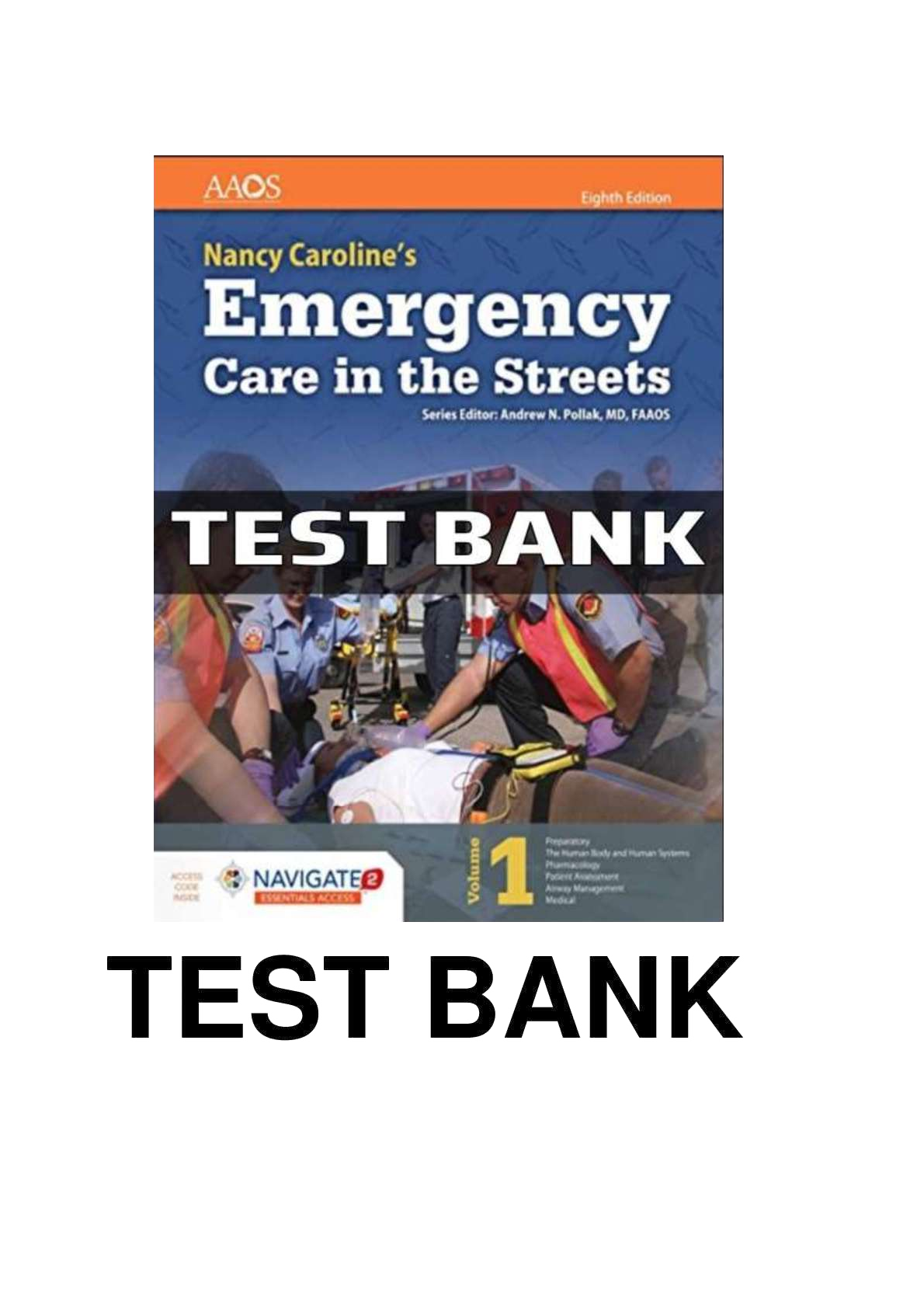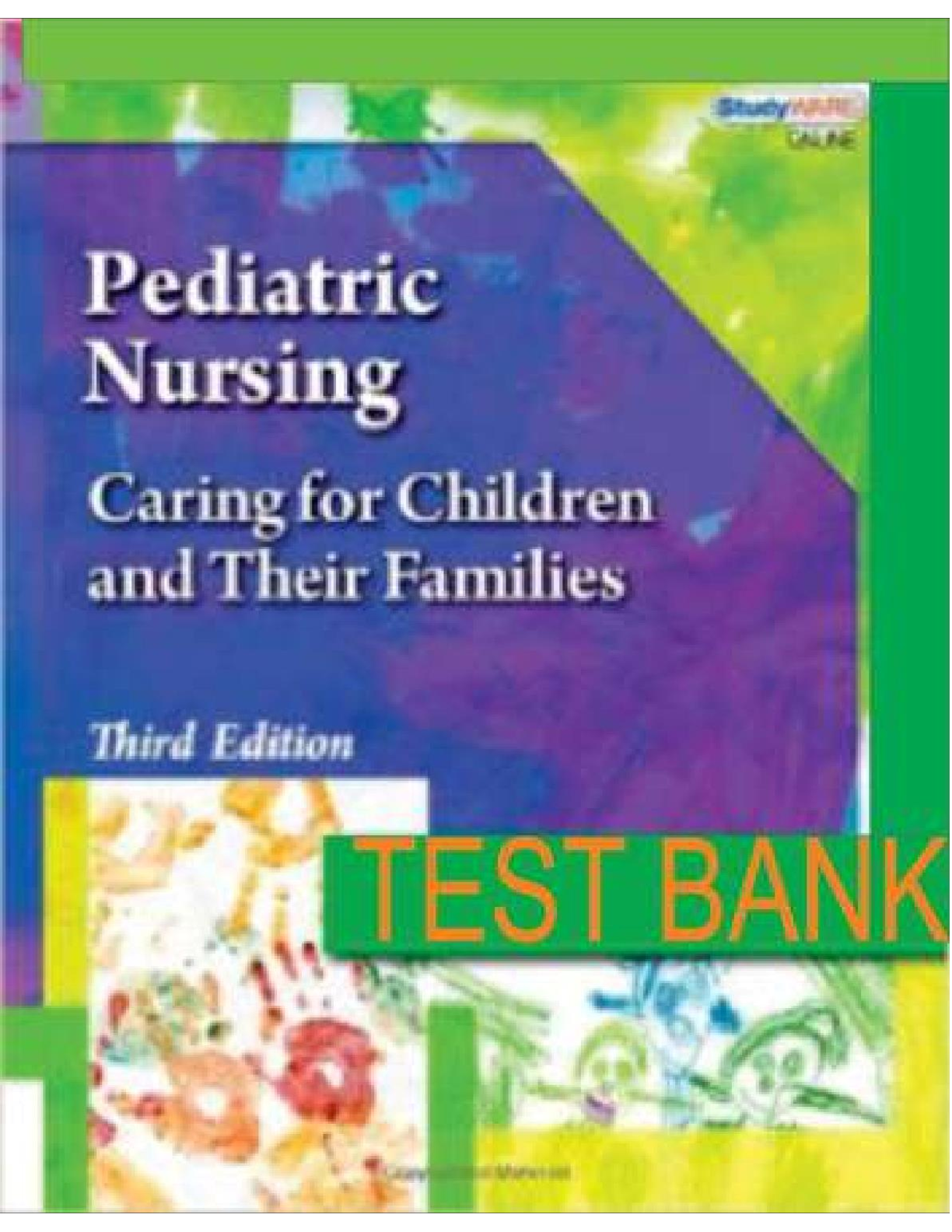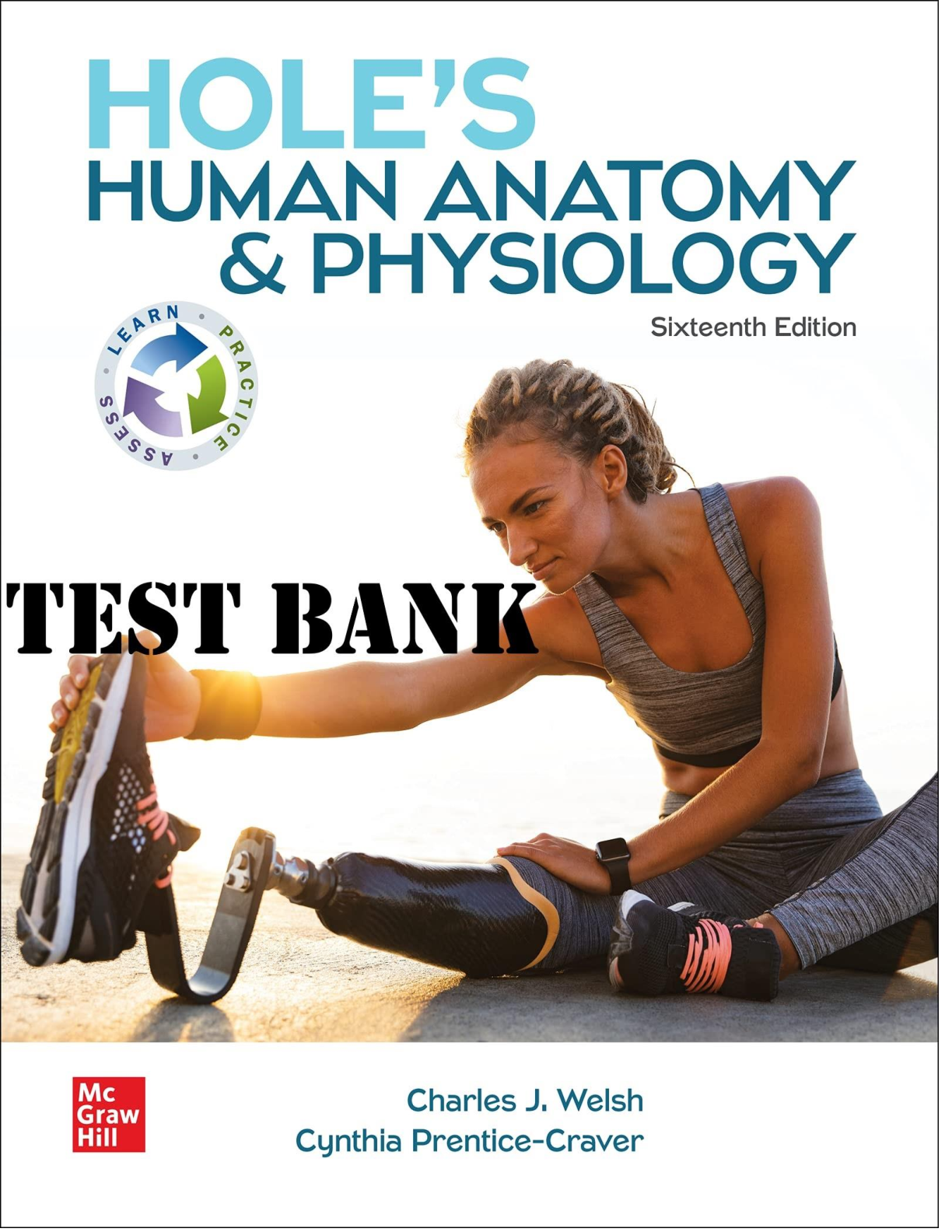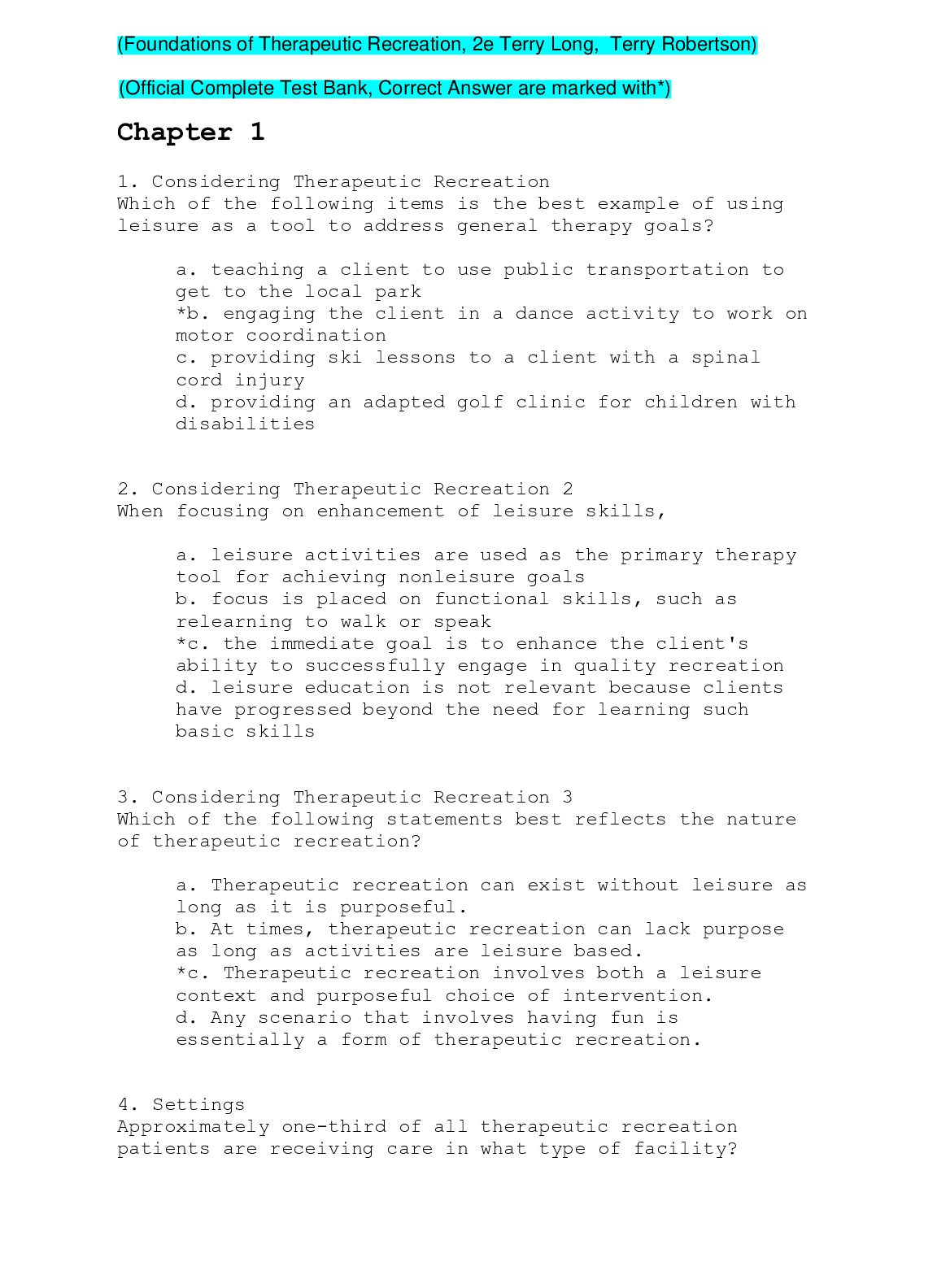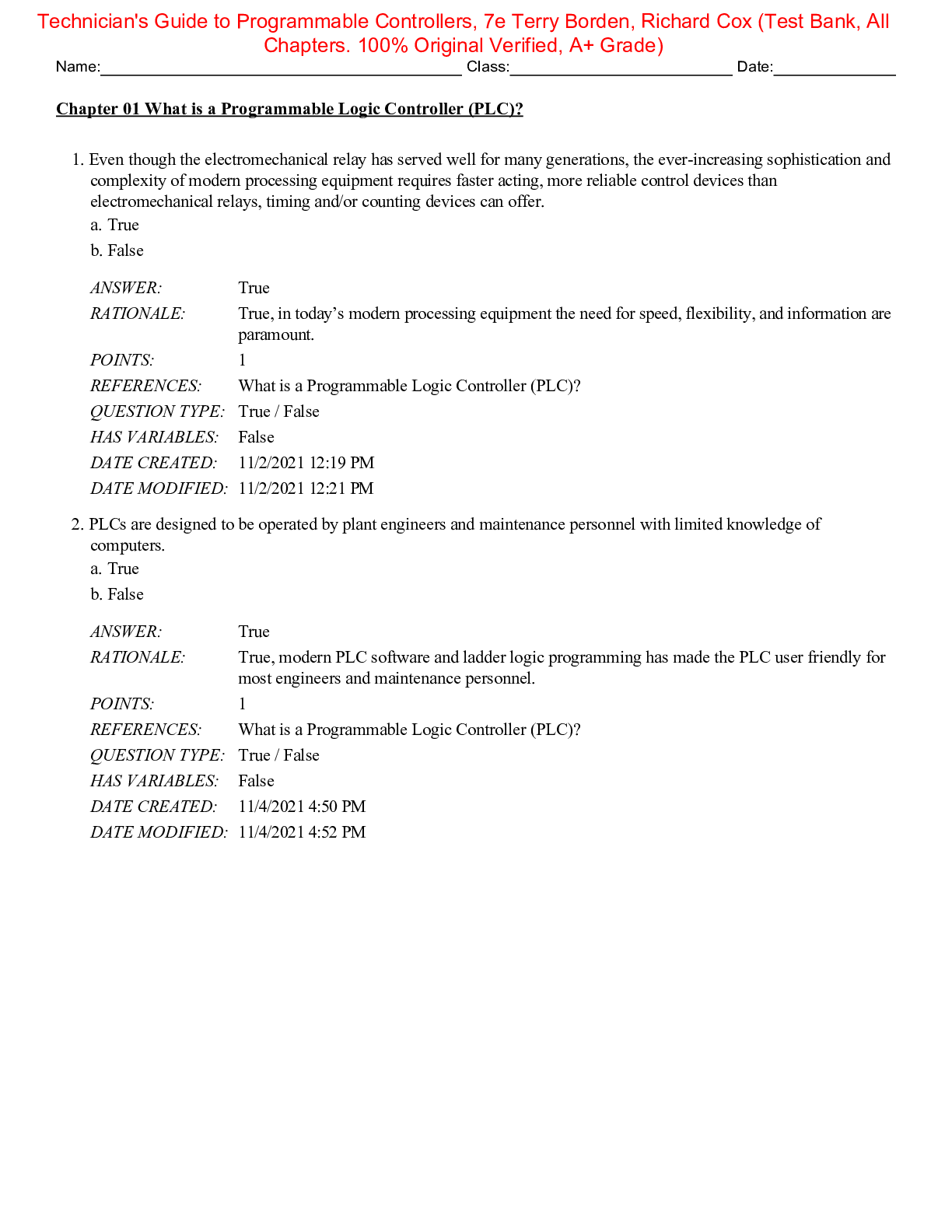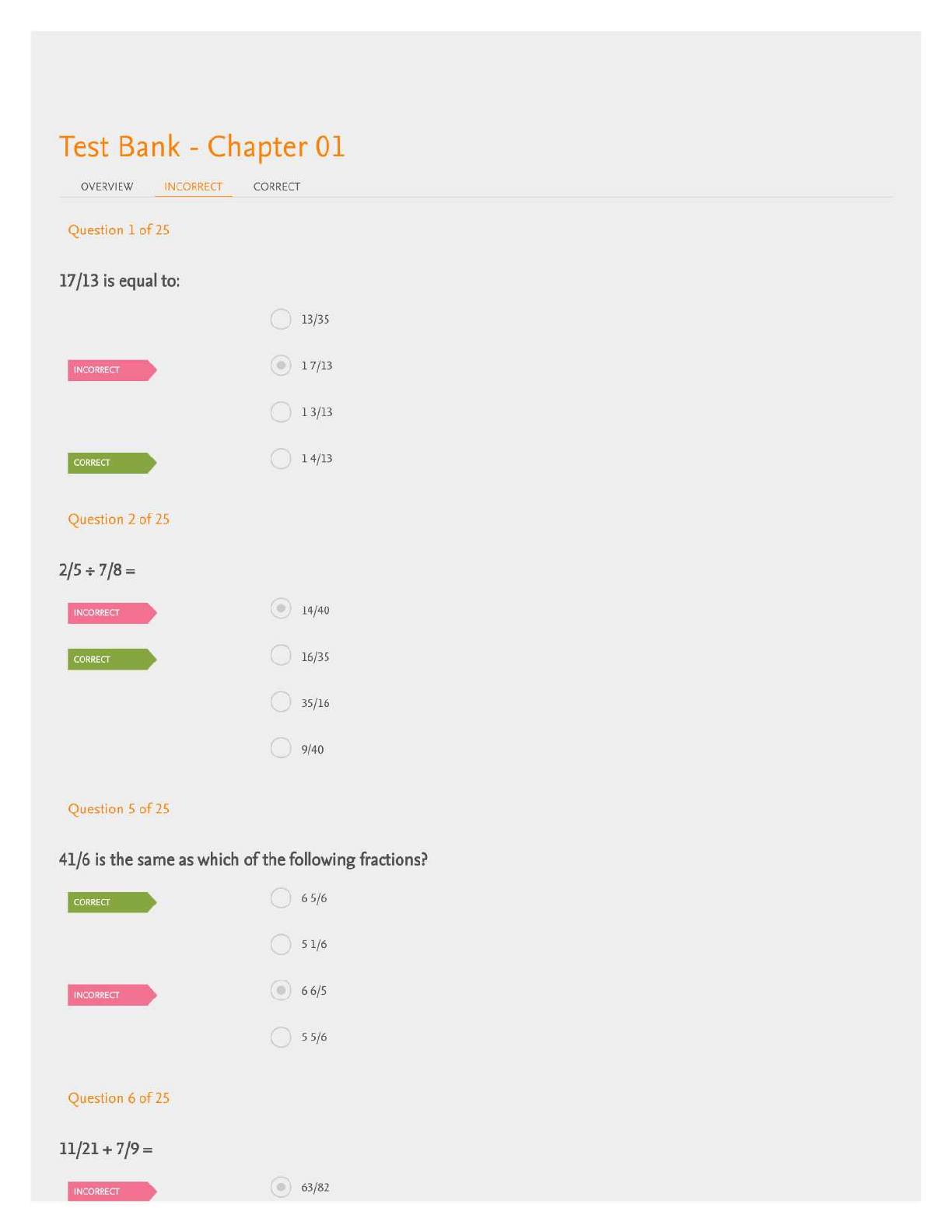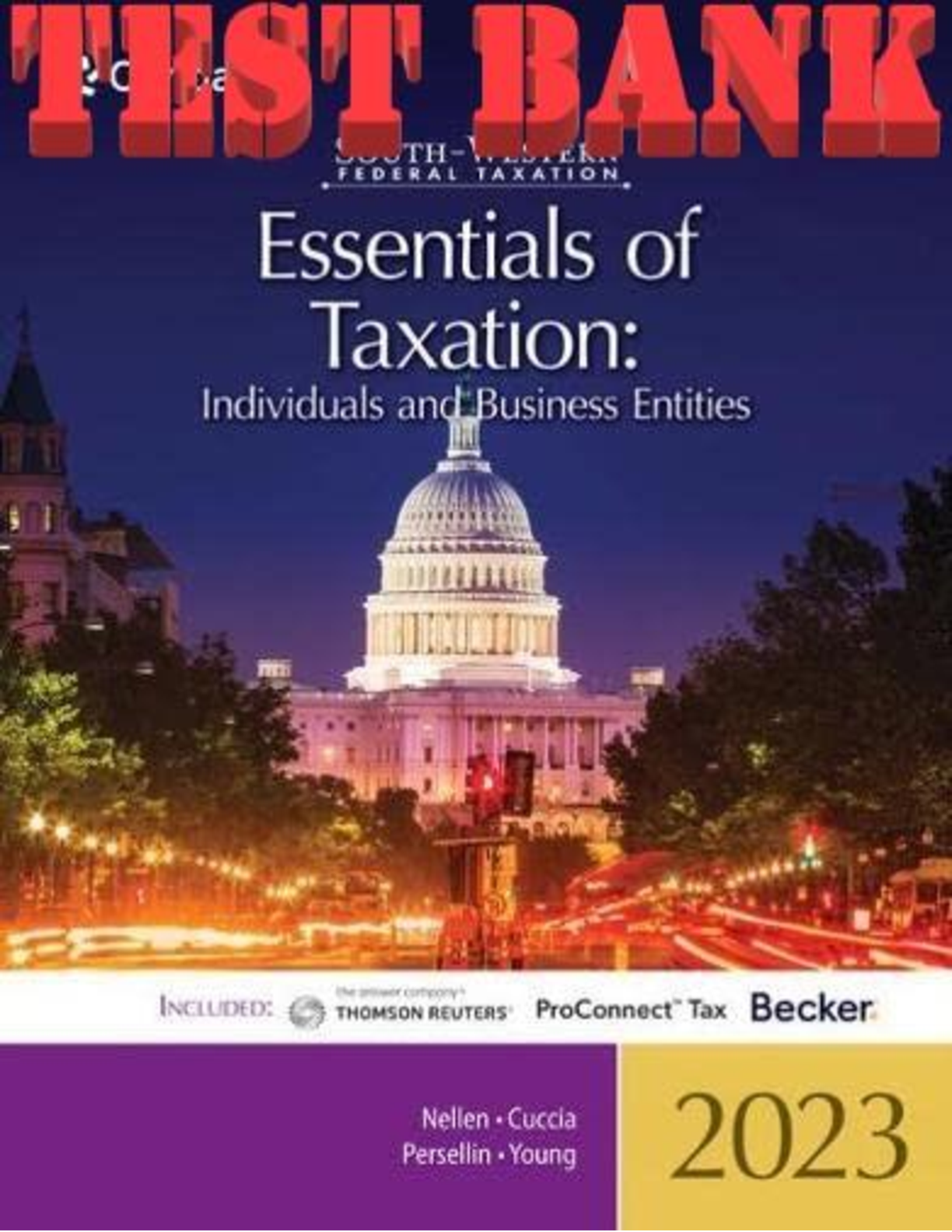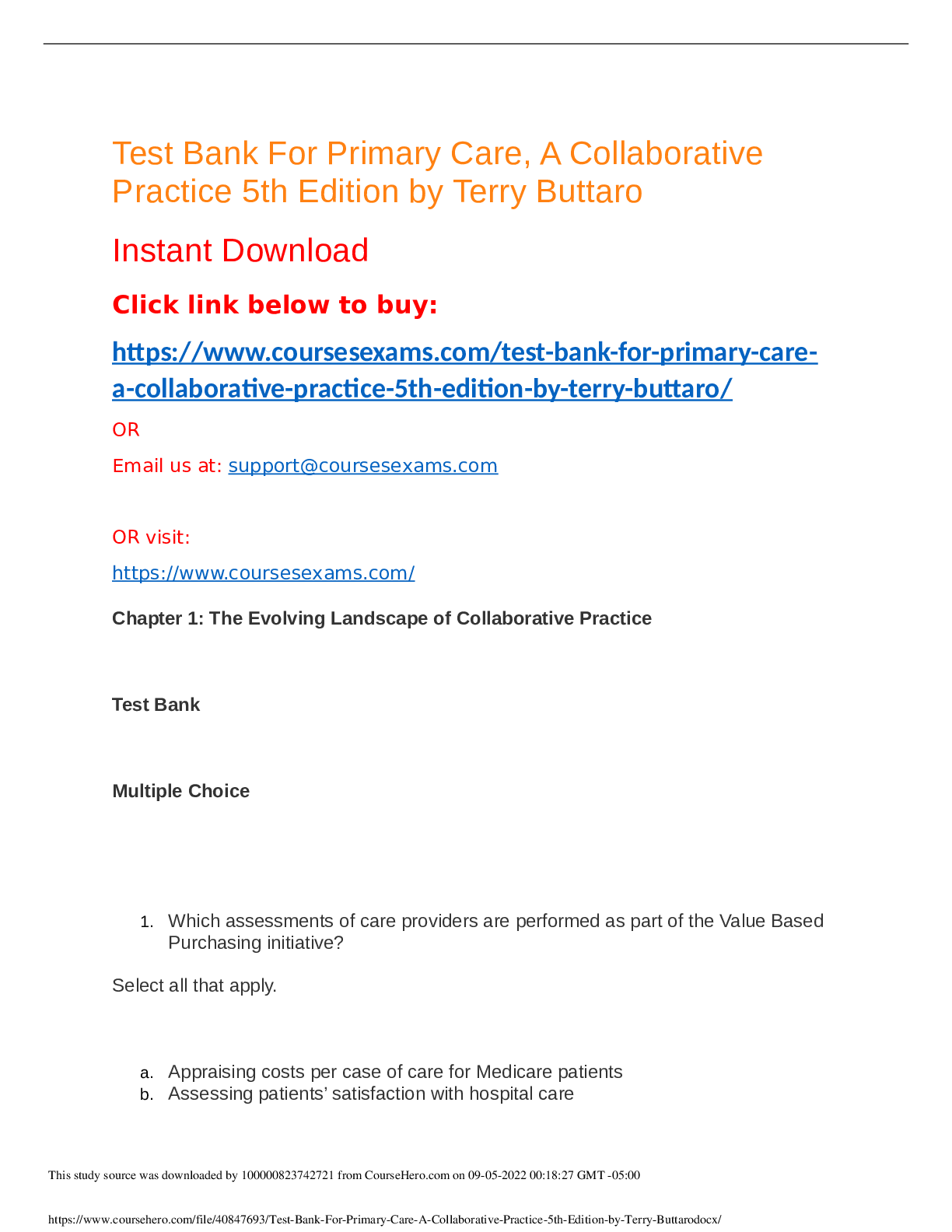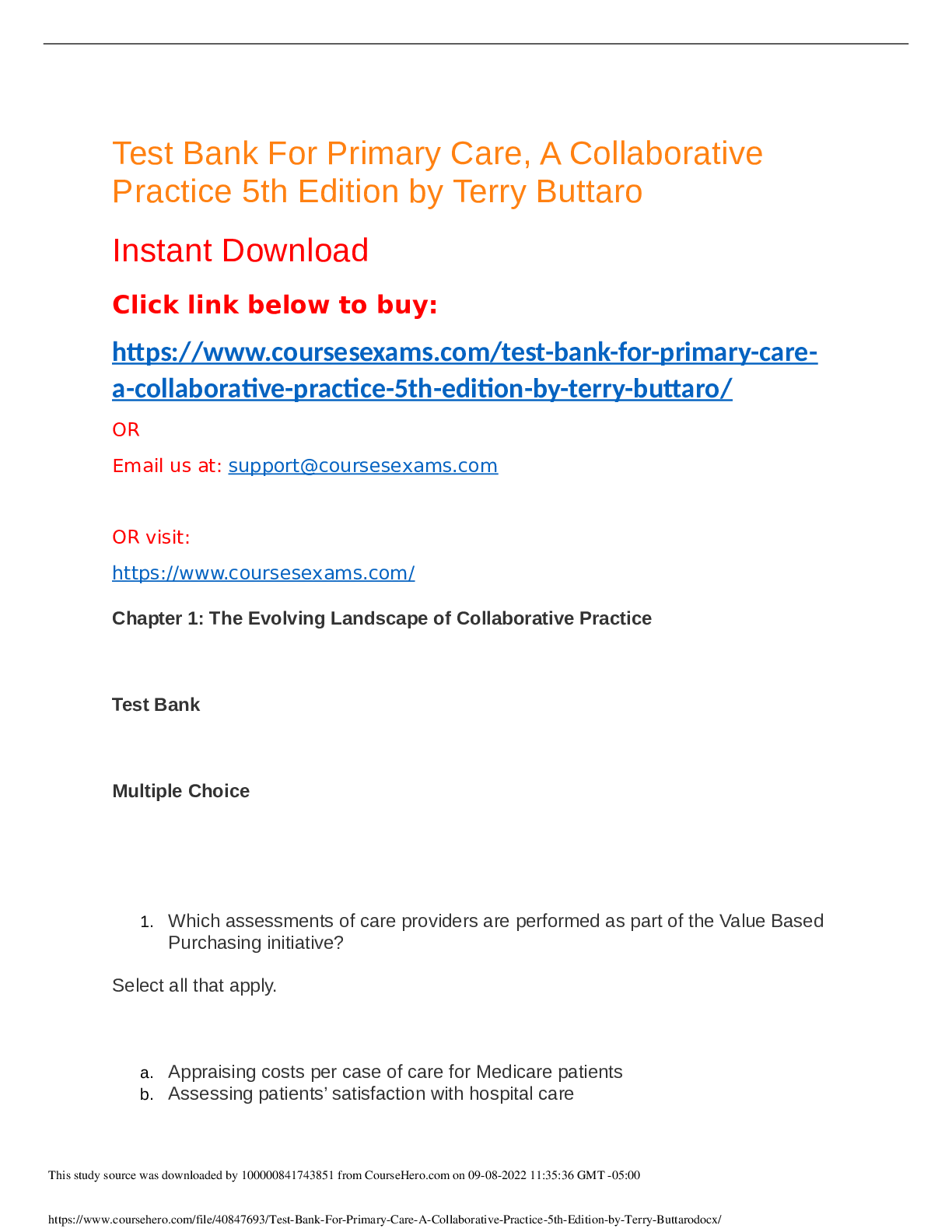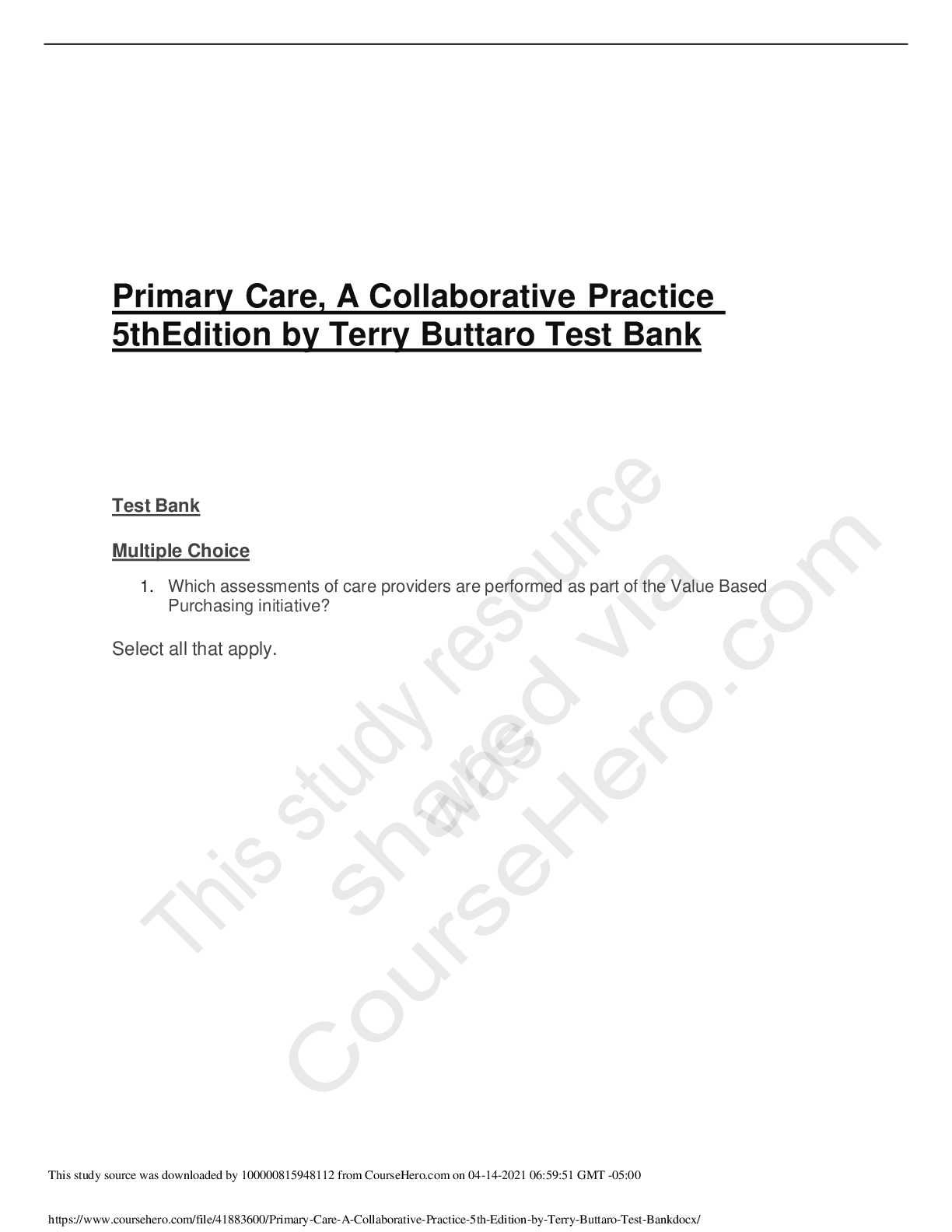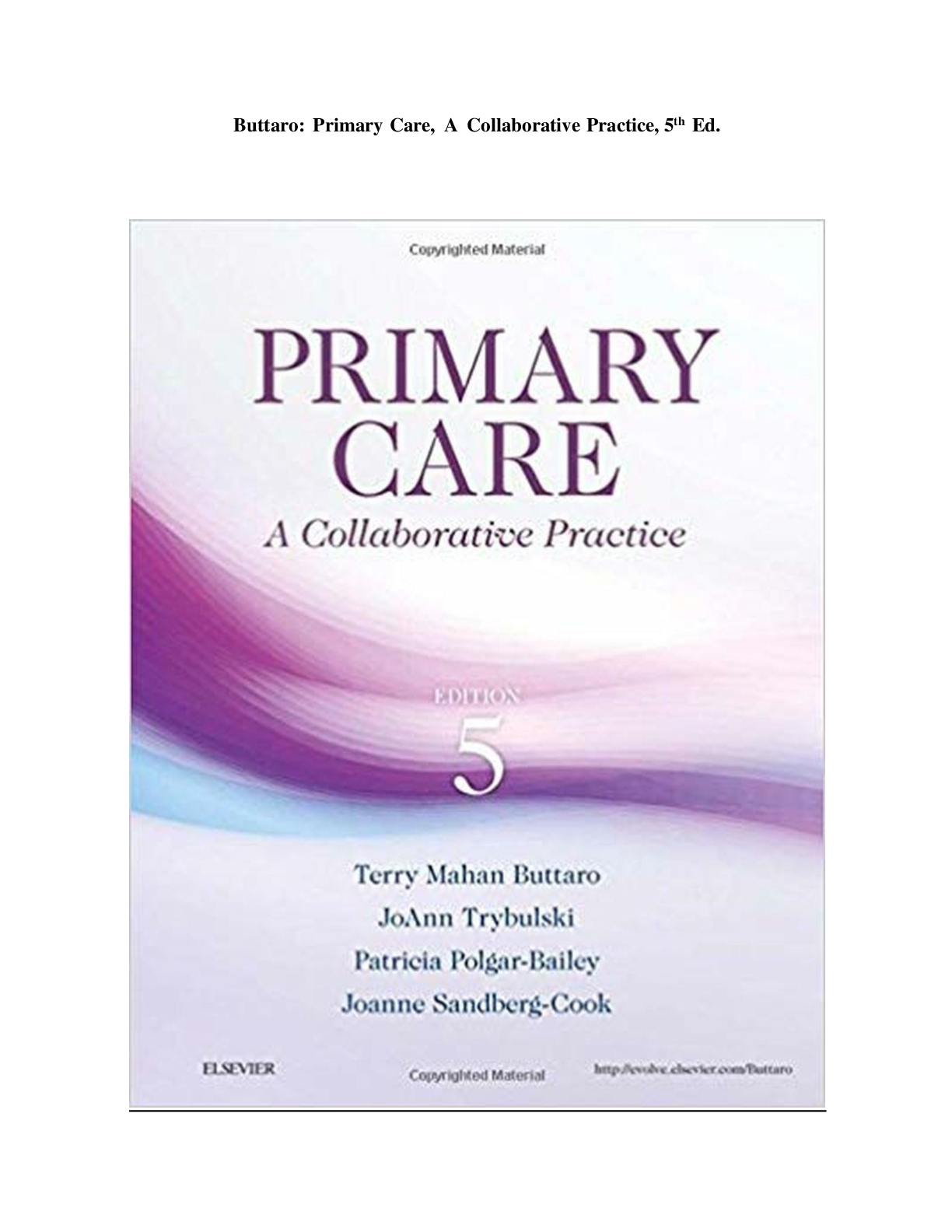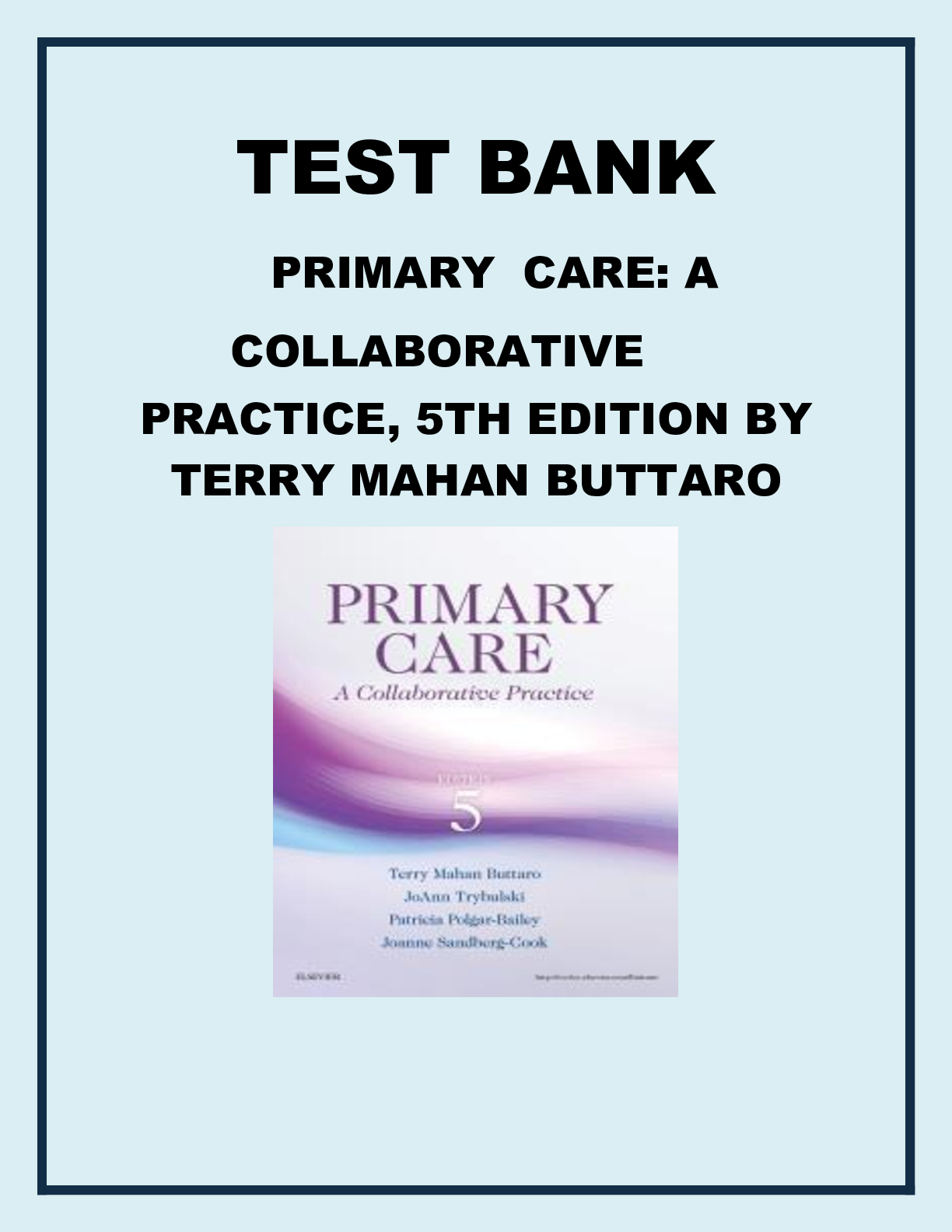Veterinary Medicine > TEST BANK > TEST BANK for Essential Calculations for Veterinary Nurses and Technicians 3rd Edition by Terry Lake (All)
TEST BANK for Essential Calculations for Veterinary Nurses and Technicians 3rd Edition by Terry Lake DVM and Nicola Green RVN. All Chapters 1-18. (Complete Download).
Document Content and Description Below
TEST BANK for Essential Calculations for Veterinary Nurses and Technicians 3rd Edition by Terry Lake DVM and Nicola Green RVN. All Chapters 1-18. (Complete Download). Test Bank - Chapter 01 OVERVIE... W Question 1 of 25 17/13 is equal to: ( 13/35 - ( 1 7/13 ( 1 3/13 ~ - ( 14/13 Question 2 of 25 2/5 + 7/8 = - ~ 14/40 - ( ; 16/35 ( 35/16 ( 9/40 Question 5 of 25 41/6 is the same as which of the following fractions? - ( 6 5/6 ( 5 1/6 - ( 6 6/5 ( 5 5/6 Question 6 of 25 11/21 + 7/9 = - ( 63/82 - ( 82/63 ( 77/82 ( 82/77 Question 7 of 25 2/13 + 5/12 = ( 10/156 - ~ 25/156 ( 7/156 - ( 89/156 Question 8 of 25 76/9 isequal to: ( 4 8/9 ~ - ( 8 4/9 - 7 6/9 ~ ( 9 4/8 Question 9 of 25 1/3 + 3/4 = , ( 1 1/3 - ~ 1 1/4 ( ) 1 1/7 - ( 1 1/12 Question 11 of 25 11/15 + 3 1/2 = ( 105/22 - (, 11/30 ~ - ( 22/105 ( 30/11 Question 12 of 25 7 4/11 is equal to: ~ ( 74/11 - ( 81/11 - ( 28/11 ( 4/77 Question 13 of 25 3 2/7 is the same as which of the following improper fractions? - ( 23/7 - ~ 9/7 ( 9/3 ( 23/3 Question 14 of 25 3/5 + 2/5 + 7/10 + 4/15 = - (~ 59/30 ( 16/35 - 16/15 ~ ( 16/30 Question 15 of 25 3/4 + 2/3 + 5/6 + 1/12 = - ( 2 1/3 - ( 2 1/4 ( 2 1/6 ( 2 1/12 Question 16 of 25 8/3 x 2/11 = ( 33/16 ( I 10/14 - ~ 16/14 - ( I 16/33 Question 17 of 25 S 7/9 is equal to: ~ - ( 52/9 - ~ 52/7 ( 57/9 ,,.. ( 35/9 Question 18 of 25 7/3 x 8/9 = ~ - ( 56/27 ( 27/56 - ~ 56/18 ( 64/27 Question 19 of 25 4 1/3 is the same as which of the following fractions? ( 13/4 <• 12/4 ::nr:mm ./ --, . , ( 12/3 ~ - ( 13/3 Question 20 of 25 29/9 isequal to: ( 2 3/9 ~ - ( 3 2/9 - 2 2/9 ~ ( 1 3/9 Question 21 of 25 3/7 x 7/9 = - ( 1/3 - (• 1/7 ( 1/9 ( ) 1/16 Question 22 of 25 3 6/7 isequal to: - ( 27/6 36/7 - ( 18/7 ( 21/7 Question 23 of 25 4/7 + 3/5 = ~ ( 13/35 - 12/21 ( 20/35 - ( 20//21 Question 24 of 25 3/13 + 5 1/3 - ( 9/208 ( 3/39 - ~ 48/39 ( 39/48 Question 25 of 25 1/5 x 3/13 = - ,,.. ( 3/65 - ( , 6/65 ( 65/6 ( 65/3 Test Bank - Chapter 01 OVERVIEW Question 3 of 25 2 3/8 is the same as which of the following fractions? ( 19/3 ~ ( 11/8 - 19/8 ~ ( 11/3 Question 4 of 25 S 2/11 is equal to: ( 27/11 - ~ 57/11 ( 27/5 ( 57/5 Question 10 of 25 9/7 + 4/5 = ( 45/40 ( 13/35 - ( 45/28 ( 28/35 Test Bank - Chapter 02 OVERVIEW Question 2 of 25 Where necessary, the answer has been rounded to three decimal places. 11/2% expressed as a decimal is: ( 0.15 ~ ( 1.5 - 15 ~ ( O.Ql5 - Question 3 of 25 Where necessary, the answer has been rounded to three decimal places. 8% x 4% = ( 0.032% - ~ 32% ( 3.2% - ( 0.32% Question 5 of 25 Where necessary, the answer has been rounded to three decimal places. 67.5% expressed as a decimalis: - ( 0.675 - 0.0675 ~ ( 67.5 ( 6.75 Question 7 of 25 Where necessary, the answer has been rounded to three decimal places. 1.6%x 3% = - ( 0.048% - ~ 0.48% ( 4.8% ( 48% Question 8 of 25 Where necessary, the answer has been rounded to three decimal places. 12%x 68% = ( 0.0816% - ~ 0.816% ( 81.6% - ( 8.16% Question 9 of 25 Where necessary, the answer has been rounded to three decimal places. 12 1/2% expressed as a decimal is: - ( 0.125 ( 1.25 - 12.5 ( 125 Question 11 of 25 Where necessary, the answer has been rounded to three decimal places. 26 1/4% is equivalent to: ( 0.026 - ( 0.263 - ( 0.0576 ( 0.5766 Question 12 of 25 Where necessary, the answer has been rounded to three decimal places.32% + 8% = - ( 400% - (, 4% ~ ( 40% ( 0.4% Question 14 of 25 Where necessary, the answer has been rounded to three decimal places. 24%+ 1.25%= ~ ( 2.252% - 22.525% ~ ( 2.525% - ( 25.25% Question 15 of 25 Where necessary, the answer has been rounded to three decimal places. 47% + 33%= - ( 80% ( 800% - ~ 0.8% ( 0.08% Question 19 of 25 Where necessary, the answer has been rounded to three decimal places. 18%+ 3% = - ( 600% ( 60% - 6% ( 0.6% Question 20 of 25 Where necessary, the answer has been rounded to three decimal places. 89%+ 4% = ( 0.93% - ( 9.3% - ( 93% ( 930% Question 21 of 25 Where necessary, the answer has been rounded to three decimal places. 42 2/3% expressed as a decimal is: ( 42.6 ( 4.26 - ( 0.426 - ~ 0.0426 Question 22 of 25 Where necessary, the answer has been rounded to three decimal places. 16% + 0.4% = ~ ( 4% - ~ 40% ( 400% ,,.. ( 4000% - Question 23 of 25 Where necessary, the answer has been rounded to three decimal places. 1.321x 1.3 = ~ ( 1.615 - ( 1.717 - ~ 2.921 ( 0.021 Question 24 of 25 Where necessary, the answer has been rounded to three decimal places. 72 1/4% x 19.5% = - ( I 14.1% ::nr:mm ( 141.1% ( 0.00141% Question 25 of 25 Where necessary, the answer has been rounded to three decimal places. 48% + 51% = ( 0.99% ~ ( 9.9% - 999% ~ - ( 99% Test Bank - Chapter 02 OVERVIEW Question 1 of 25 Where necessary, the answer has been rounded to three decimal places. 34.5% x 7.8% = ( 26.91% - ( 2.691% ( 0.02691% ~ ( 0.002691% Question 4 of 25 Where necessary, the answer has been rounded to three decimal places. 10% + 4% = ( 2.5% ( 25% - ~ 250% ( 0.25% Question 6 of 25 Where necessary, the answer has been rounded to three decimal places. 8.4% expressed as a decimalis: ( 84 ( 8.4 - ( 0.084 ( 0.84 Question 10 of 25 Where necessary, the answer has been rounded to three decimal places. 3% x 12% = ( 0.036% - ~ 0.36% ( 3.6% ( 36% Question 13 of 25 Where necessary, the answer has been rounded to three decimal places. 67% expressed as a decimal is: ( 67 ( 6.7 - ~ 0.67 ( 0.067 Question 16 of 25 Where necessary, the answer has been rounded to three decimal places. 66 1/3 expressed as a decimal is: ( 0.066 , - ( 0.663 ,,.. ( 6.633 ~ ( 66.333 Question 17 of 25 Where necessary, the answer has been rounded to three decimal places. 3.065+ 0.23= ( 0.133 ( ) 1.332 - ( 13.326 ( ) 133.26 Question 18 of 25 Where necessary, the answer has been rounded to three decimal places. 54%x 52%= ( 2.808% - (, 28.08% ~ ( 280.8% , ( 0.2808% Test Bank - Chapter 03 OVERVIEW Question 1 of 22 Adding, subtracting, multiplying and dividing with scientificnotation 6.3 x 10-4 ( 0.063 - ( 0.0063 - ( 0.00063 ~ ( 0.000063 Question 2 of 22 Adding, subtracting, multiplying and dividing with scientificnotation 9.2 x 10-3 ( 0.092 - ( 0.0092 - ~ 0.00092 ( 0.000092 Question 3 of 22 Adding, subtracting, multiplying and dividing with scientificnotation 3.7 x 10-5 ( 0.0037 - ~ 0.00037 - ( 0.000037 ( 0.0000037 Question 4 of 22 Adding, subtracting, multiplying and dividing with scientificnotation (4.2 x 103)+ (1.8 x 102) ( 2.33 x 104 ( 2.33 x 103 - ~ 2.33 x 105 - ( 2.33 x 101 Question 5 of 22 Adding, subtracting, multiplying and dividing with scientificnotation (3.8 x 104) x (1.25 x 106) ( 4.75 x 106 - ~ 4.75 x 102 ( 4.75 x 108 - ( 4.75 x 1010 Question 7 of 22 Adding, subtracting, multiplying and dividing with scientificnotation 7.68 x 107 ( 768000 , - ( 7680000 ,,.. ( 76800000 ~ - ( 76800000 Question 8 of 22 Adding, subtracting, multiplying and dividing with scientificnotation (4.4 x 102) x (9.2 x 104) - ( 4.048 x 107 ( 4.048 x 106 - ( 4.048 x 108 ( 4.048 x 109 Question 9 of 22 Adding, subtracting, multiplying and dividing with scientificnotation 8.4 x 10-2 - ( 0.084 - (, 0.0084 ~ ( 0.84 ( 8.4 Question 10 of 22 The following numbers are expressed in scientific notation; how would the number look not in scientific notation? 5.7 x 10-2 - ( 0.057 ( 0.57 - 5.7 ( 57 Question 13 of 22 The following numbers are expressed in scientific notation; how would the number look not in scientific notation? 6.7 x 102 - ~ 6.7 ( 67 - ( 670 ( 6700 Question 15 of 22 Adding, subtracting, multiplying and dividing with scientific notation (5.4 x 102)+ (2.6 x 104) ( 2.077 x 104 - ( 2.077 x 105 - ( 2.077 x 10-2 ~ ( 2.077 x 10-6 Question 16 of 22 Adding, subtracting, multiplying and dividing with scientific notation(3.2x 104)+(2x 10-2) / - l.6xlOL ( ) 1.6 x 106 - ( 8 x 103 ( 8 x 107 Question 17 of 22 Adding, subtracting, multiplying and dividing with scientific notation (7.6 x 10-3) x (2.4 x 10-4) ( 1.824 x 10-3 - (• 1.824 x 10-4 ( 1.824 x 10-5 - ( ) 1.824 x 10-6 Question 18 of 22 Adding, subtracting, multiplying and dividing with scientific notation (5.2 x 10-2) x (3.2 x 10-2) ~ ( 1.664 x 10-2 - ,,.. ( 1.66 x 10-3 ~ ( 1.66 x 10-4 - 1.66 x 10-5 Question 19 of 22 The following numbers are expressed in scientific notation; how would the number look not in scientific notation? 4.161 x 105 ( 41.61 - ~ 4161 ( 41610 - ( 416100 Question 20 of 22 Adding, subtracting, multiplying and dividing with scientific notation (2.2 x 104) x (2.2 x 102) ( 4.84 x 102 ( 4.84 x 104 - ( 4.84 x 105 - ( 4.84 x 106 Question 22 of 22 Adding, subtracting, multiplying and dividing withscientificnotation 8.6 x 105 - ( 860000 ( 86000 - ( 8600 ( 860 Test Bank - Chapter 03 OVERVIEW Question 6 of 22 Adding, subtracting, multiplying and dividing with scientific notation 2.1 x 103 x 4.7 x 10-4 ( 9.87 ( 9.87 x 102 - 9.87x10- 1 ( 9.87 x 10-2 Question 11 of 22 The following numbers are expressed in scientific notation; how would the number look not in scientific notation? 8.2 x 10-6 ( 0.00000082 - ~ 0.0000082 ( 0.000082 ( 0.00082 Question 12 of 22 Adding, subtracting, multiplying and dividing with scientific notation (7.1 x 102)+(1.1 x 10-3) ( 6.45 x 10-2 ( 6.45 x 102 - 6.45xl0 5 ( 6.45 x 10-1 Question 14 of 22 The following numbers are expressed in scientific notation; how would the number look not in scientific notation? 3.95 x 103 ( 39.5 ( 395 - ~ 3950 ( 39500 Question 21 of 22 Adding, subtracting, multiplying and dividing withscientificnotation 3.6 x 102 x 4.2 x 103 ( ) 1.512 x 105 - ( 1.512 x 106 ( ) 1.512 x 107 ~ ( 1.512 x 108 Test Bank - Chapter 04 OVERVIEW Question 1 of 22 After reading Chapter 4 of this book, try to calculate x in the following examples. 35/x= 5/7 - 7 ( 14 - ( 49 ( 245 Question 2 of 22 After reading Chapter 4 of this book, try to calculate x in the following examples. x/4.4= 11/15.4 ( 4.24 - ~ 3.84 - ( 3.14 ( 4.4 Question 4 of 22 After reading Chapter 4 of this book, try to calculate x in the following examples. 24/25 = x/100 ( 94 - 95 ~ - ( 96 ( 98 Question 5 of 22 After reading Chapter 4 of this book, try to calculate x in the following examples. 11.5/x= 36.8/77 - ( 24.06 ( 23 - ~ 11.5 ( 32.78 Question 8 of 22 After reading Chapter 4 of this book, try to calculate x in the following examples. 4.8/3 = 1.6/x - ( - ~ 2 ( ( 4.8 Question 11 of 22 After reading Chapter 4 of this book, try to calculate x in the following examples. 49/7 = 294/x ( 7 ~ - ( 42 - 49 ~ ( 294 Question 12 of 22 After reading Chapter 4 of this book, try to calculate x in the following examples. x/6 = 5/16.8 - ( 1.79 - ~ 2.1 ( ( 2.8 Question 13 of 22 After reading Chapter 4 of this book, try to calculate x in the following examples. 2.15/3.65= 7.955/x ( 10.2 ( 11.237 - ( 12.308 - ( 13.505 Question 17 of 22 After reading Chapter 4 of this book, try to calculate x in the following examples. 126/28= 18/x - ( 4 ( 14 - ( 18 ( 28 Question 18 of 22 After reading Chapter 4 of this book, try to calculate x in the following examples. 42.9/60= x/12.24 ( 2.38 - ~ 3.8 - ( 8.76 ( 12.72 Question 19 of 22 After reading Chapter 4 of this book, try to calculate x in the following examples. 0.8/2.64= x/13.2 - ( 4 ( 5 - 6 ( 7 Question 20 of 22 After reading Chapter 4 of this book, try to calculate x in the following examples. 9.5/1.2= 28.5/x ( 1.2 - ( 2.4 - ( 3.6 ( 9.5 Question 21 of 22 After reading Chapter 4 of this book, try to calculate x in the following examples. x/1.4 = 32.4/37.8 ( ) 1.3 - ( 1.2 - (•) 1.4 ( 2.8 Test Bank - Chapter 04 OVERVIEW Question 3 of 22 After reading Chapter 4 of this book, try to calculate x in the following examples. 24/x= 5/7 ( 18.8 ( 27.4 - ( 33.6 ( 48 Question 6 of 22 After reading Chapter 4 of this book, try to calculate x in the following examples. 34.5/x= 110.4/32 ~ ( - 10 ~ ( 32 ( 34.5 Question 7 of 22 After reading Chapter 4 of this book, try to calculate x in the following examples. 9.7 /x = 1/7 ( 79.6 ( 69.7 - ( 67.9 ( 96.7 Question 9 of 22 After reading Chapter 4 of this book, try to calculate x in the following examples. 37.18/1.7= 89.23/x ( 1.7 2.04 - 4.08 ( 9.16 Question 10 of 22 After reading Chapter 4 of this book, try to calculate x in the following examples. 9.2/18.4= x/7 ( 7 - ( 3.5 ( 9.2 ~ ( 2 Question 14 of 22 After reading Chapter 4 of this book, try to calculate x in the following examples. 5/1 = 20.5/x ( ) 1 - ~ 4.1 ( ( 20.5 Question 15 of 22 After reading Chapter 4 of this book, try to calculate x in the following examples. 3/6.25= x/50 ( 8 ( 16 - ( 24 ( 32 Question 16 of 22 After reading Chapter 4 of this book, try to calculate x in the following examples. 2.4/7.2= 1/x ( 2 - Question 22 of 22 ~ ( 4 ( After reading Chapter 4 of this book, try to calculate x in the following examples. 2.45/x= 5.39/7 ( 2.45 - ~ 3.18 ( 4.23 ( 2.2 Test Bank - Chapter 06 OVERVIEW Question 1 of 25 Your 6 kg patient is being fed through a nasogastric tube. The patient requires 240 kcal of liquid feed divided into 8 equal feeds. The nutrition contains 1.9 kcal/ml. How many millilitres are administered per feed? (To the nearest millilitre) - ( 15 ml - ( 30 ml ( 45 ml ( 60 ml Question 2 of 25 A client calls in to collect prescription of antibiotics (Synulox 250 mg tablets) for her dog. The dosage rate is 12.5 mg/kg body weight twice daily and the dog weighs 32 kg. How many tablets are required for the full 21 days course? (Round up to the nearest whole tablet.) - ( 63 tablets - ~ 84 tablets ( 106 tablets ( 125 tablets Question 4 of 25 A 40-kg Labrador attends your weight clinic. You recommend that the dog needs to lose 20% of its body weight. What is the dog's target weight? ( 18 kg - ( 20 kg - ( 32 kg ~ ( 38 kg f"'I, ,or+i~~ t. ~+"1C 'cUC:.:H.IVI I V VI LJ A 19-kg dog needs medication in the form of Clindaseptin 25 mg/ml oral solution. The dose rate is 5.5 mg/kg. How much does the dog require per dose? (To the nearest millilitre) ( 3 ml - ( 4 ml - ~ 5 ml ( 6 ml Question 7 of 25 Tablets are available in 120 mg strength. Your patient requires 30 mg. How much of the tablet do you administer? - ( Quarter ( ; Third - Half ~ ( Three quarters Question 8 of 25 A 1.7-kg rabbit requires an injection of Hypnorm for sedation. The dose rate is 0.3 ml/kg as part of a combination. How much is required? (To the nearest tenth) , - ( 0.3 ml - ,,.. ( 0.5 ml ~ ( 1.2 ml ( 1.7 ml Question 10 of 25 A lame dog weighing 12.S kg requires pain-killing medication, carprofen, in tablet form. The recommended dose rate is 4 mg/kg as a single daily dose for 7 days and then reduce to 2 mg/kg. The tablets are available in 20 mg, SO mg, and 100 mg strengths and the dog needs a 10 day course. Which tablets would you choose, how many do you need to supply and at what dose? - ( 10 x 100 mg tablets: 1/2 tablet daily for 7 days, then 1/4 tablet daily ( ) 11 x 20 mg tablets: 11/2 tablets daily for 7 days, then 1 tablet daily ( 16 x 50 mg tablets: 2 tablets daily for 7 days, then 1 tablet daily - 10 x 50 mg tablets: 1 tablet daily for 7 days, then 1/2 tablet daily Question 11 of 25 A 23-kg dog requires an injection of nonsteroidal anti-inflammatory drug (Meloxicam) 5 mg/ml. The dose is 0.2 mg/kg. How much should you inject? ( 0.6 ml ~ - ( 0.9 ml - 1.2 ml ~ ( 2.3 ml Question 12 of 25 Your practice has been analysing its current patient registrations. They have 2642 dogs, 1247 cats, 214 small mammals, 49 birds and 97 reptiles. What amount of all patients are small mammals? - ( 5% - (•) 1/5 ( 29% ( 1/16 Question 13 of 25 A 10 kg dog has been receiving fluid therapy at a rate of 6 mL/h. The fluid has been running for 8 hours and 20 minutes. How much fluid has the dog received so far? ( 20 ml 30 ml - ( 40 ml - ( 50 ml Question 14 of 25 Your patient requires medication in the form of 75 mg tablets. The patient needs 25 mg. What fraction of the tablet do you administer? ( 1/2 - 1/3 - (•) 1/4 ( 1/5 Question 18 of 25 Your patient requires feeding through a feeding tube. He needs 450 kcal/day divided into 6 feeds. The liquid feed contains 2.1 kcal/ml. How many millilitres does he need per feed? (Round to the nearest millilitre.) ( 15 ml - ( 35 ml - ~ 75 ml ( 155 ml Question 19 of 25 A 23-kg dog needs 4% Epiphen oral drops, at 0.06 ml/kg/day as a single dose. How much does it need per day? (To the nearest tenth) ~ ( 1.1 ml ( 1.2 ml , - ( 1.4 ml - ,,.. ( 1.5 ml Question 20 of 25 A 5-kg cat requires tablets medication for a skin condition. The tablets are available in 5 mg strength and the dose rate is 2 mg/kg/day. How many tablets would you dispense for 10 days? ( 10 tablets - ( 15 tablets - ( 20 tablets ( 25 tablets Question 21 of 25 Your 15 kg patient requires an injection of medication that has a dose rate of 10 mg/kg. The medication contains 50 mg/ml. How much do you inject? - 3 ml - ( 4 ml ( 5 ml ~ ( 6 ml Question 22 of 25 An 18-kg Border collie requires an injection of antibiotic (cephalexin); the dose is 10 mg/kg and the strength of the medication is 180 mg/ml. What quantity would you inject the dog with? - ( 1 ml ( 2 ml - ( 3 ml ( 4 ml Question 23 of 25 A 7-kg dog requires Tolfedine tablets. The recommended dosage is 4 mg/kg once daily. The tablets are available in 20 mg tablets. What is the daily dose? ( ) 1 tablet - ( 1.5 tablets - ~ 2 tablets ( 2.5 tablets Question 24 of 25 A dog breeder wants to worm a litter of puppies with Drontal oral suspension. The dose is 1 ml/kg body weight. She has fivepuppies each weighing approximately 4.5 kg. How much suspension would you dispense for a single dose for all of the puppies? ~ ( 9.5 ml - 19 ml ~ - ( 22.5 ml ( 26.5 ml Test Bank - Chapter 06 OVERVIEW Question 3 of 25 A dog attends your weight clinic. She currently weighs 38 kg and needs to lose 15% of her body weight. What is her target weight to the nearest kilogram? ~ ( 15 kg ( 22 kg - ( 32 kg ( 35 kg Question 5 of 25 A 26-kg dog needs an antibiotic injection. The dose rate is 12 mg/kg and the strength of the antibiotic is 150 mg/ml. What quantity of antibiotic do you inject? ( ) 1.1 ml - ( 2.1 ml ( 3.1 ml ( 4.1 ml Question 9 of 25 A 4-kg cat requires frusemide (furosemide) 40 mg oral tablets to help reduce oedema. The dose is 5 mg/kg twice daily. How many tablets would you supply for the next 21 days? ( 42 tablets ( 28 tablets - 21 tablets ( 14 tablets Question 15 of 25 A 3.7-kg cat requires treatment of cyclosporine 100 mg/ml for chronic allergic dermatitis. The recommended dose is 7 mg/kg/day for 4 weeks. If each bottle contains 5 ml, how many bottles will you need to dispense? - ~ 2 bottles ( 3 bottles ( 4 bottles ( 5 bottles Question 16 of 25 A 4.5-kg cat requires an injection of a drug that contains 40 mg/ml. The dose rate is 5 mg/kg. How much does the cat need? ( 0.2 ml ( 0.4 ml , ( 0.6 ml - ,,.. ( 0.8 ml Question 17 of 25 Cimetidine oral syrup contains 40 mg/ml and a 28-kg German Shepherd Dog requires 7 mg/kg every 6 hours. How many millimetres will the dog receive over the next 7 days? - 137.2 ml ~ ( 196 ml ( 34.3 ml ~ ( 1372 ml Question 25 of 25 Your patient is receiving i.v. fluids at a rate of 8 ml/h. The fluid has been running for 4 hours and 15 minutes. How many millilitres has your patient received? ( 32 ml - ( 34 ml ( 36 ml ( 38 ml Test Bank - Chapter 07 OVERVIEW Question 1 of 20 You weigh out 4 lb of dry dog food. How much is this in grams? ( 454 g - ( 635 g ( 908 g - ( 1814 g Question 2 of 20 A reptile weighs 12 oz. How much is this in grams? - ( 340 g ( 350 g - ~ 360 g ( 370 g Question 3 of 20 7.4 litres is equal to: ( 10 pints - 4.5 quarts ~ ( 25 US cups - ( 1.95 gallons Question 4 of 20 An owner brings her puppy to you to be weighed. It weighs 4.3 kg. The owner wants to know what this is in pounds. ( 1.95 lb ( 2.2 lb - ~ 8.63 lb - ( 9.47 lb Question 7 of 20 An owner walks his dog twice a day for 3 miles each walk. How many kilometres does it walk in 5 days? ( 44.1 km - ~ 45 .2 km ( 47.1 km - ( 48.2 km Question 8 of 20 A 24-kg dog is receiving fluid at a rate of 40 ml/kg/day. How much fluid does it receive per hour? - ( 40 ml ( 80 ml - I 120 ml ,,.. I 160 ml Question 9 of 20 A client runs 6.5 miles with her dog. What distance is the dog running in kilometres? ( 2.9 km - ( 6.6 km - ( 10.4 km ( 26 km Question 10 of 20 You need to administer medication to a cat weighing 13 lb. The dose for the medication is 4 mg/kg. How many milligrams do you administer? ( 22 mg - ( 24 mg - ( 26 mg ( 28 mg Question 11 of 20 A rat weighing 170 g requires an injection of antibiotic at a dose of 300 mg/kg. The antibiotic is available in a strength of 0.2 mg/mL.What volume of antibiotic do you need? ( 0.002 ml - ( 0.025 ml - ( 0.25 ml ( 2.5 ml Question 12 of 20 An owner thinks her pet is drinking excessively. She has measured its intake and it is drinking 4 pints daily. How much is this in millilitres (imperial)? ( 960 ml ( 1880 ml - ( 2280 ml - ~ 4160 ml Question 13 of 20 A dog drinks 2.5 pints of water on a daily basis. How much is this in litres (to the nearest tenth)? ( 1.2 l - ( 1.3 l - ( 1.4 l ~ ( 1.5 l Question 14 of 20 A client's reptile weighs7 oz. Convert this to grams. - ( 198.5 g ( 209.5 g - ~ 231 g ( 258.5 g Question 15 of 20 A 1.5-kg bag of dog food is the equivalent of how many pounds? ( ) 1.1 lb - ~ 2.2 lb - ( 3.3 lb ,,.. ( 4.4 lb Question 16 of 20 A dog cage measures 42.1 inches. What is this in centimetres? ( 52cm - ( 107 cm ( 124 cm - 173 cm Question 18 of 20 An owner tells you her pet weighs 1.5 lb. What is this in grams? ( 620 g ( 640 g - ~ 660 g - ( 680 g Question 20 of 20 A doe: weie:hine: 16 ke:has been receivine: intravenous fluids at a rate of 50 mL/ke:/24 hour. The infusion has been ..., ..., ..., ..., ..., running for 2 days. What is the total volume of fluid the dog has received? ( 400 ml - 800ml ( 1200 ml - ( 1600 ml Test Bank - Chapter 07 OVERVIEW Question 5 of 20 A 3-kg cat is receivingi.v.fluid therapy at 60ml/kg/day. How much does it receive after the first 18 hours? ( 100 ml - ( 135 ml ( 150 ml ~ ( 185 ml Question 6 of 20 The newly built reception desk in your practice is 5.5 yards long. What is that distance in metres? ( 1.67 m ( 3.44 m - ~ 5.02 m ( 5.99 m Question 17 of 20 A cat has lost 3 lb following your weight loss programme. How much is this in kilograms? - 1.3 kg ( 2.3 kg ~ ( 4.3 kg ( 5.3 kg Question 19 of 20 A dog weighs1 stone,121/2lb. What does it weigh in kilograms? ( 11 kg - ~ 12 kg ( ) 13 kg ( 14 kg Test Bank - Chapter 08 OVERVIEW Question 2 of 20 A 12-kg dog requires medication at 2 mg/kg/day. The tablets are available in 25 mg strength. How many tablets should be dispensed for a 5-day course? ~ - ( - 7.5 ~ ( 10 ( 15 Question 3 of 20 A 3-kg cat needs 2 mg tablets at a dose rate of 1 mg/kg bid for 10 days. How many tablets should be dispensed? (Calculate to the nearest whole tablet.) ( 3 tablets ( 15 tablets - ~ 20 tablets - ( 30 tablets Question 4 of 20 You have been asked to prepare tablets for a 32-kg dog. The tablets are available in 200 mg strength, the dose is 6 mg/kg bid, and the length of the course is 28 days. How many tablets do you count? - ( 56 tablets - ( 84 tablets ( 112 tablets ~ ( 140 tablets Question 5 of 20 An owner calls in to collect a prescription of cephalexin oral drops. The suspension, once reconstituted, contains 100 mg/ml. The dose rate for a 20-kg dog is 15 mg/kg twice a day. What is the daily amount the dog receives? ( 3 ml - ( 6 ml - ~ 9 ml ( 12 ml Question 6 of 20 A 22-kg dog needs medication at 30 mg/kg once a day. The medication is available as a 60 mg/ml oral suspension. For a 5-day course, how many millilitres will be required? ( ) 11 ml - ~~ 33 ml - ( 55 ml ,,.. ( 77 ml Question 7 of 20 A 3-kg cat needs oral medication at a dose of 10 mg/kg/day. The medication is available at 20 mg/ml. How many millilitres will it have received after 4 days? ,,.. I 4 ml - ( 6 ml ( 8 ml - I 10 ml Question 9 of 20 A 3-kg cat requires a daily dose of sucralfate three times daily for 6 days. The suspension contains 200 mg/ml and the dose rate is 250 mg p.o. q8h. How much do you need to dispense? ( 11.25 ml - ( 22.5 ml - ( 42.25 ml ( 67.5 ml Question 10 of 20 Tablets come in a 25 mg strength and a 10-kg dog has received 20 tablets for a 10 day course. What is the dose rate? - ( 5 mg/kg/day ( 10 mg/kg/day - ( 12 mg/kg/day ( 15 mg/kg/day Question 11 of 20 A cat requires oral medication in the form of Enrofloxacin suspension 25 mg/ml. The dose for your 4.5 kg cat is 5 mg/kg once daily for 10 days. How much would you supply? ( 0.9 ml - ( 1.9 ml - ( 9 ml ( 90 ml Question 12 of 20 A 15-kg dog requires 25 mg tablets. The dosing instructions are 3 mg/kg daily (to the nearest whole tablet). How many tablets need to be dispensed for a 10-day course? ( 15 - ( 20 - ( 25 ~ ( 30 Question 15 of 20 The vet prescribes a 15-kg dog with Kaogel suspension. The oral dose is 0.5 ml/kg/day divided into four daily doses. How much does the dog require for a single dose? (Round to the nearest tenth.) ~ - ( 1.9 ml - 7.5 ml ~ ( 15 ml ( 30 ml Question 16 of 20 A 19-kg dog needs prednisolone at a dose of 2 mg/kg split into 2 doses/day. How many tablets are required for 14 days if the tablet strength is 5 mg? ( 38 tablets ( 57 tablets - ~ 76 tablets - ( 112 tablets Question 17 of 20 A 14 kg dog requires a dose of 5 mg/kg once daily. The tablets are available in 20 mg strength. How many tablets does the dog need on a daily basis? r ( 1.5 - ( 2 - ( 3.5 ~ ( 4 Question 18 of 20 A 6-kg cat requires pradofloxacin 25 mg/ml oral suspension once daily. He is hospitalised with you for 3 days and the dose is 5 mg/kg daily. How much does he receive during his stay? ~ ( 0.6 ml () 1.2 ml - ( 2.4 ml - ( 3.6 ml Question 19 of 20 Tablets are available in a strength of 5 mg and a cat weighing 4.5 kg requires a dose of 1 mg/kg three times daily for 5 days. How many tablets do you dispense to the cat's owner? - ( 5 ( 10 - ( 15 ( 20 Question 20 of 20 A 23-kg dog requires an oral suspension at a dose of 0.5 ml/kg tid. How much should the dog have received after 14 days? ( 161 ml ~ ( 280 ml - ( 483 ml - ( 497 ml Test Bank - Chapter 08 OVERVIEW Question 1 of 20 A 4.5-kg cat requires medication at a dose rate of 5 mg/kg once daily for the next 7 days. The tablets are available in 10 mg strength. How many tablets are required? (Calculate to the nearest whole tablet.) ~ ( 3 tablets ( 7 tablets - ( 16 tablets ( 20 tablets Question 8 of 20 A 2-kg kitten needs some antibiotics at a dose of 10 mg/kg. The medication is available in 15 mg/ml. How many millilitres are required for a single dose? ( ) 1.1 ml - ( 1.3 ml ( ) 1.5 ml ( 1.7 ml Question 13 of 20 A 6-kg cat requires tablets that are available in 25 mg strength. The dose required is 2 mg/kg twice daily and they should be given as a 10-day course. How many tablets should you dispense? ( - ( 10 ( 15 ~ ( 20 Question 14 of 20 A 12-kg dog has been prescribed 50 mg tablets for 21 days. The dose is 2 mg/kg tid. What number of tablets is required? ( 21 tablets ( 24 tablets - ~ 32 tablets ( 36 tablets Test Bank - Chapter 10 OVERVIEW Question 1 of 13 2000 g is how many kilograms? - 0.02kg ( 0.2 kg - ( 2 kg ( 20 kg Question 3 of 13 How many milligrams of a drug is contained in 1.6 ml of a 5-mg/ml solution? ( 2 mg - ~ 4 mg ( 6 mg - ( 8 mg Question 4 of 13 360 ml is the same as: ( 0.036 L - ( 0.36 L ( 3.6 L - 36 L Question 11 of 13 How many grams is 10 mg? ( 0.001 g - ( 0.01 g - ~ 0.1 g ( ) lg Question 12 of 13 A 24-kg dog needs 15 mg/kg of medication that comes in 100 mg tablets. How many tablets do you give? - ~ 1.5 tablets ( 2.5 tablets - ( 3.5 tablets ( 4.5 tablets Question 13 of 13 A 16-kg dog needs 20 mg/kg of medication that comes in 120 mg capsules. How many capsules do you give? ( 1 capsule , - ( 2 capsules - ,,.. ( 3 capsules ~ ( 4 capsules Test Bank - Chapter 10 OVERVIEW Question 2 of 13 The drug dose for a dog is 1 mg/kg per day. The dog weighs 19 kg and the medication comes in 7 mg tablets. How many tablets do you give? ~ ( 1 tablet ( 2 tablets - ( 3 tablets ( 4 tablets Question 5 of 13 A 10-lb dog needs 25 mg/kg of medication. How many milligrams do you give? - ( 114 mg ( 124 mg ( ( 134 mg 144 mg Question 6 of 13 0.6 kg of water is how many millilitres? ( 200 ml ( 400 ml - 600 ml ( 800 ml Question 7 of 13 A cat weighing 4 kg needs insulin at 2 units/kg. The insulin is available in 40 units/ml. How much insulin do you give? ( 0.02 ml - ( 0.2 ml ( 2 ml ( 2.2 ml Question 8 of 13 A dog weighing 25 kg needs medication at a dose of 2 mg/kg. The tablets are available in 10 mg strength. How many tablets does the dog need? ( 2 tablets 3 tablets ( 4 tablets - 5 tablets Question 9 of 13 How many milligrams of a drug is found in 20 ml of a 4.5-mg/ml solution? ~ ( ,,.. 0.9 mg ( 9 mg - ( 90 mg ( 900 mg Question 10 of 13 A 20-kg dog needs 0.2 mg/kg of a medication that comes in 8 mg tablets. How many does he need? - ~ 112tablet 1 tablet ( ( ; 1112tablets ( 2 tablets Test Bank - Chapter 11 OVERVIEW Question 1 of 15 How many milligrams of active ingredient does a 5% solution have per millilitre? - 0.05 mg ~ ( 0.5 mg ( 5 mg ~ ( 50 mg - Question 3 of 15 Calculate the amount of diluent required to make 100 ml of a 20% solution from a stock solution which is 80%. ( 85 ml - ( 75 ml - ~ 65 ml ( 55 ml Question 4 of 15 How much diluent is needed to make 500 ml of a 2% solution from a stock solution of 10%? ( 490 ml - 450 ml ( 425 ml - ( 400 ml Question 6 of 15 How much of a 70% solution would be required to make 20 ml of a 10% solution? - ( 2.85 ml - ~ 28.5 ml ( 285 ml ( 2850 ml Question 8 of 15 How much diluent is required to make 400 ml of a 5% solution from a stock solution of 60%? - ~ 0.36 ml ( 3.66 ml ( 36.66 ml - ( 366.7 ml Question 9 of 15 A cat requires a 3-ml injection of a 0.5% solution. How many milligrams will it receive per injection? ( 0.15 mg , - ( 1.5 mg - ,,.. ( 15 mg ~ ( 150 mg Question 10 of 15 How much of a 60% solution is needed to make SO ml of a 15% solution? - ( 12.5 ml ( 15 ml ( 75 ml - ( 750 ml Question 11 of 15 If you have a 22% solution, how many milligrams of active ingredient is contained in each millilitre? - ( 22 mg - (~ 220 mg ( 2.2 mg ( 2220 mg Question 12 of 15 You need SO ml of a 2.5% solution and you have a stock solution of 10%. How much of this do you require? ~ ( 1.25 ml - ( 12.5 ml - ( 125 ml ( 1250 ml Question 13 of 15 You require 60 ml of a 5% solution. You have a stock solution available to you in 20% strength. How much of the 20% stock solution will you need? ( 5 ml - ~ 10 ml - ( 15 ml ( 20 ml Question 14 of 15 You require 25 ml of a 7% solution. There is a 25% stock solution available for use. How much of this do you require? - ( 7 ml ( 14 ml ( 25 ml - ( 36 ml Question 15 of 15 If 100 ml of a solution contains 20 g, how many milligrams will 20 ml contain? - 40 mg ( 400 mg - ( 4000 mg ( 40,000 mg Test Bank - Chapter 11 OVERVIEW Question 2 of 15 What quantity of a 30% solution do you need to make 150 ml of a 20% solution? ( 50 ml - ( 100 ml ( 150 ml ~ ( 200 ml Question 5 of 15 If you have an 18% solution, how many milligrams is in each millilitre of solution? ( 1.8 mg ( 18 mg - (•, 180 mg ( 1800 mg Question 7 of 15 If 100 ml of a solution contains 30 g of solute, how many milligrams of solute can be found in 15 ml of solution? ( 0.45 mg ( 4.5 mg ( 45 mg - 450mg Test Bank - Chapter 13 OVERVIEW Question 1 of 22 A patient is receiving fluids at 50 ml/kg/day. After 15 hours the patient has received 687.5 ml. How heavy is your patient? ( 12 kg - 15kg ( 17 kg - ( 22 kg Question 2 of 22 For the last 6 hours a 15-kg dog has been receiving fluid therapy at a rate of 40 ml/kg/24 hours. How much fluid has the dog received so far? - ( 150 ml ( 100 ml ( 75 ml - ~ 25 ml Question 3 of 22 A 34-kg dog is receiving a fluid infusion at 5 ml/kg/hour. How much fluid is received after 75 minutes? ~ ( 3.5 ml - 170 ml ~ - ( 212.5 ml ( 340 ml Question 4 of 22 A 17-kg dog requires 15 ml/kg of fluid every 24 hours. How much fluid will it have received after 6 hours? ( 10.6 ml - ( 63.7 ml - ~ 175.8 ml ( 255 ml Question 5 of 22 A 4-kg cat is receiving IVFT at a rate of 60 ml/kg/24 hours. How many millilitres of fluid will be received in 41/2 hours? - ~ 4.5 ml ( ; 10 ml ( 24 ml - ( 45 ml Question 6 of 22 A 6-kg cat is receiving intravenous fluid therapy at a rate of 50 ml/kg over the next 24 hours. How many millilitres is it receiving per hour? - ( 12.5 ml ~ ( 15.2 ml - 19.6 ml ~ ( 21.5 ml Question 7 of 22 A patient weighing 22 kg needs fluid at a rate of 40 ml/kg/day. How much fluid is the patient receiving hourly? - ( 30 ml - ( 36.7 ml ( 40 ml ( 46.7 ml Question 8 of 22 Intravenous fluid therapy is stopped on a 17-kg dog 36 hours after starting. The dog has received 1020 ml in total. What was the infusion rate? - 30 ml/kg/24 hours - ( 40 ml/kg/24 hours ( SO ml/kg/24 hours ( 60 ml/kg/24 hours Question 9 of 22 A 16-kg dog is receiving i.v. fluids at a rate of 60 ml/kg/day. How much is that per minute? - ( 0.67 ml ~ ( 1.67 ml - ~ 2.67 ml ( 3.67 ml Question 10 of 22 A 13-kg dog is receiving fluids intravenously at a rate of 20 ml/kg over 24 hours. How much fluid would the dog receive after 18 hours? ( 10.8 ml - ~ 26 ml ( 96 ml - ( 195 ml Question 11 of 22 Your 16 kg patient has been receiving fluid at a rate of 60 ml/kg/24 hours for the last 10 hours. How much fluid has he received? - ( 40 ml ( 96 ml - ( 400 ml ( 960 ml Question 12 of 22 A 3-kg cat is receiving fluid at a rate of 10 ml/kg/hour. How many millilitres will it receive in 2.5 hours? ( 30 ml - ( 75 ml - ~ 125 ml ( 175 ml Question 13 of 22 A 12-kg dog is receiving fluid at a rate of 15 ml/kg/hour. How many millilitres will the dog have received after 12 hours? ( 180 ml - 1850 ml ~ - ( 2160 ml ,,.. ( 3240 ml Question 15 of 22 A 35-kg dog is receiving 50 ml/kg/24 hours of i.v. fluid. How much fluid will it have received after 15 hours? 73 ml - ( 1094 ml , ( 1550 ml - ,,.. ( 1750 ml Question 16 of 22 A 45-kg dog is receiving fluid at 12 ml/kg/hour. How many millilitres will the dog have received after 40 minutes? - ( 220 ml - ( 360 ml ( 470 ml ( 540 ml Question 18 of 22 A 27-kg dog is receiving fluid at a rate of 60 ml/kg/day. How much fluid will the dog receive per minute? ( 2.1 ml - ( 1.9 ml ( 1.7 ml ~ ( 1.1 ml - Question 19 of 22 A 26-kg dog is receiving maintenance fluids at a rate of 40 ml/kg/24 hours. How many millilitres is it receiving per hour? ~ - ( 43.3 ml ( 86.6 ml ( 94.2 ml - (•1 1040 ml Question 20 of 22 A 23-kg dog is receiving fluid at a rate of 60 ml/kg in 24 hours. How many millilitres are received per hour? - ~ 26.5 ml - ( 57.5 ml ( ( 60 ml 138 ml Question 21 of 22 A 2-kg kitten is receiving fluid intravenously at a rate of SO ml/kg/day. How much fluid will it receive after S hours? ~ ( 4.2 ml - ( 20.8 ml - ( 25 ml ( 50.3 ml Question 22 of 22 A 6-kg cat is receiving fluid at a rate of 15 ml/kg/hour. How much fluid will the cat receive after 3 hours? - ( 45 ml - ~ 90 ml ( 180 ml ( 1080 ml Test Bank - Chapter 13 OVERVIEW Question 14 of 22 A 35-kg dog is receiving 50 ml/kg/day of i.v.fluids. How many millilitres does he receive per minute? - 1.2 ml ~ ( 2.4 ml ( 3.6 ml ~ ( 4.8 ml Question 17 of 22 How much fluid would a 19-kg dog receive in 10 hours if fluid was given at a rate of 40 ml/kg/day? ( 31.6 ml ( 76 ml - ~ 316.7 ml ( 760 ml Test Bank - Chapter 15 OVERVIEW Question 1 of 5 A 2% solution is diluted 1/10. What is the final concentration? - ( 0.2% ( 2% - 4% ( 20% Question 2 of 5 A 30% solution is diluted 3/10. What is the final concentration? ( 3% - ~ 6% - ( 9% ( 12% Question 3 of 5 A 70% solution was diluted to produce a 40% solution. How much was it diluted? - 1/4 ( 1/7 - ( 4/7 ( 1 3/4 Question 4 of 5 A solution was diluted 1/40 and the final concentration was 20%. What was the original concentration? ( 80% ( 100% - ~ 400% - ( 800% Question 5 of 5 What was the original strength of the solution if it is diluted 1/50 and the finalconcentration is 4%? ( 40% - ~ 50% ( 100% - ( 200% Test Bank - Chapter 17 OVERVIEW Question 1 of 25 A dog weighing 24 kg requires 1.5 times its RER. How many kilocalories is this per day? ( 790 kcal - ( 1027 kcal - ( 1185 kcal ~ ( 1580 kcal Question 2 of 25 What is the RER of a 17-kg dog? ( ) 117 kcal - ( 580 kcal ( 820 kcal - ~ 1220 kcal Question 3 of 25 Calculate the energy requirement of an 8-kg dog that requires twice its RER. ( 155 kcal - 310 kcal ~ - ( 620 kcal ( 930 kcal Question 4 of 25 A 6-kg puppy still requires the energy requirement for growth. How many kilocalories does it need per day? ( 150 kcal ( ) 175 kcal - ~ 250 kcal - ( 375 kcal Question 6 of 25 Calculate the resting energy requirement (RER) for a 12-kg dog. ( 360 kcal - ( 430 kcal ( 840 kcal - ( 870 kcal Question 7 of 25 Calculate the RER for a 6-kg dog. ( 100 kcal ( 150 kcal - 200 kcal - ( 250 kcal Question 8 of 25 Calculate the energy requirement of a 24-kg bitch in her last trimester of pregnancy. - 790 kcal - ( 1027 kcal ( 1580 kcal ( 1738 kcal Question 10 of 25 A 13-kg dog is in the last trimester of pregnancy. Calculate her RER. ( 327 kcal ( 460 kcal - ( 598 kcal - 640 kcal Question 11 of 25 A 16-kg dog requires the energy requirement for a maintenance state. What is this in kilocalories? 440 kcal - 550 kcal - ( 660 kcal ( 770 kcal Question 12 of 25 A 12-kg dog requires twice its RER. How many kilocalories per day is this? - ( 860 kcal ( 900 kcal ( 980 kcal - (e 1 1020 kcal Question 13 of 25 A 19.6-kg Border collie is in the third trimester of pregnancy. Calculate the energy requirement of this dog. ( 658 kcal - ( 752.7 kcal - ( 855.4 kcal ~ ( 943 kcal Question 14 of 25 A dog weighing 36 kg should ideally weigh 27 kg. What would you recommend its energy requirement to be to assist weight loss? - ( 686 kcal - ( 704 kcal ( 796 kcal ( 880 kcal Question 15 of 25 A 24.5-kg dog should ideally weigh 15 kg. What is the recommended energy requirement to assist weight loss? ( 321 kcal - ( 416 kcal - ~ 531 kcal ( 653 kcal Question 17 of 25 A 22.3-kg dog is an extremely active working dog. What is its energy requirement? ,,.. ( 739 kcal ~ ( 1032 kcal - 1264 kcal ~ - ( 1478 kcal Question 18 of 25 A 20-kg dog is a very active working dog. Calculate a suitable energy requirement. - 670 kcal 1005 kcal - ( ) 1340 kcal ( 2010 kcal Question 19 of 25 A 21-kg working dog is extremely active. Calculate its energy requirements. - ( 1400 kcal - Question 20 of 25 ( ( llOO kcal 700 kcal 350 kcal What is the resting energy rate for a 14.S-kg dog? ( 302 kcal - 406 kcal - ( 505 kcal ( 603 kcal Question 22 of 25 What is the RER of a 36-kg dog? ( 936 kcal - (e 1 1080 kcal - ( ll50 kcal ( 2550 kcal Question 24 of 25 Calculate the maintenance energy requirement of a 19-kg dog. - ( 640 kcal ~ - ( 768 kcal ( 1280 kcal ~ ( 1408 kcal Question 25 of 25 A moderately active 12 kg working dog needs his energy requirement calculated. What is it? - 430 kcal - 537.Skcal ( 642 kcal ( 747.5 kcal Test Bank - Chapter 17 OVERVIEW Question 5 of 25 A growing 4 kg puppy has an energy requirement of how many kilocalories? ( 420 kcal - ( 380 kcal ( 190 kcal ~ ( 134 kcal Question 9 of 25 A 27-kg dog is recovering following surgery. Calculate his ideal energy requirement to aid recovery. ( 880 kcal - ~ 1320 kcal ( ) 1760 kcal ( 2200 kcal Question 16 of 25 What is the energy requirement of a 6-kg cat that should weigh3.5 kg? ( 140 kcal - 175 kcal ~ ( 262.5 kcal ( 367.5 kcal Question 21 of 25 Calculate the energy requirement of a 16-kg bitch feeding a litter of puppies. ( 550 kcal ( ) 1100 kcal ( 1400 kcal - ( 2200 kcal Question 23 of 25 Calculate the energy requirement for a 19.4-kg dog following surgery. ( 523 kcal ( 652 kcal - ~ 978 kcal ( 1026 kcal Test Bank - Chapter 18 OVERVIEW Question 1 of 18 The table below shows a dog's glucose results taken over 8 hours.13.824.733.845.657.265.474.483.4 What is the mode? ~ - ( 3.8 - ~ 4.4 ( 5.4 ( 7.2 Question 4 of 18 The table below shows seven students' test results.Student 177Student 235Student 392Student 456Student 590Student 638Student 756 What is the mode? - ( 56 () 77 - ~ 35 ( 92 Question 5 of 18 The table below shows a student's test score on a weekly basis.Week 123Week 220Week 328Week 428Week 525Week 621 Week 730 What is the range? - ( 10 ( 20 - 25 ( 30 Question 8 of 18 The table below shows a dog's glucose results taken over 9 weeks.Week 19.2Week 28.4Week 33.3Week 45.4Week 57.4Week 68.4Week 74.2Week 88.8Week 94.8 What is the range? ( 4.2 ( 5.6 - ~ 6.1 - ( 5.9 Question 10 of 18 The table below shows a student's test score on a weekly basis.Week 123Week 220Week 328Week 428Week 525Week 621 Week 730 What is the mode? ( 24 ( 25 ~ - ( 28 - 30 Question 12 of 18 The table below shows seven students' test results.Student 177Student 235Student 392Student 456Student 590Student 638Student 756 What is the standard deviation? ,,.. ( ( 20 - - 21.25 ( 23.35 Question 13 of 18 The table below shows seven students' test results.Student 177Student 235Student 392Student 456Student 590Student 638Student 756 What is the median? ( 35 - ( 77 - ( 56 ( 92 Question 14 of 18 The table below shows a dog's glucose results taken over 8 hours.13.824.733.845.657.265.474.483.4 What is the mean? ( 5.2 - ( 4.8 ( 5.1 - 4.9 Question 15 of 18 The table below shows a student's test score on a weekly basis.Week 123Week 220Week 328Week 428Week 525Week 621Week 730 What is the median? ( 20 - ( 24 - ( 25 ( 30 Question 16 of 18 The table below shows a dog's glucose results taken over 9 weeks.Week 19.2Week 28.4Week 33.3Week 45.4Week 57.4Week 68.4Week 74.2Week 88.8Week 94.8 What is the mean? - ( 6.66 ( 7.4 - ( 8.72 ( 5.67 Question 17 of 18 The table below shows a dog's glucose results taken over 9 weeks.Week 19.2Week 28.4Week 33.3Week 45.4Week 57.4Week 68.4Week 74.2Week 88.8Week 94.8 What is the median? ~ - ( 7.4 - ~ 5.4 ( 8.4 ( 9.2 Test Bank - Chapter 18 OVERVIEW Question 2 of 18 The table below shows a dog's glucose results taken over 9 weeks.Week 19.2Week 28.4Week 33.3Week 45.4Week 57.4Week 68.4Week 74.2Week 88.8Week 94.8 What is the mode? ~ ( 7.4 ( 4.4 - ( 8.4 ( 8.8 Question 3 of 18 The table below shows seven students' test results.Student 177Student 235Student 392Student 456Student 590Student 638Student 756 What is the mean? ( 35 - ( 63.43 ( 72.86 ( 60 Question 6 of 18 The table below shows seven students' test results.Student 177Student 235Student 392Student 456Student 590Student 638Student 756 What is the range? - ~ 57 ( 20 ( 62 ~ ( 39 Question 7 of 18 The table below shows a student's test score on a weekly basis.Week 123Week 220Week 328Week 428Week 525Week 621Week 730 What is the standard deviation? ( 4.2 - ~ 3.8 ( ) 7.6 ( 1.9 Question 9 of 18 The table below shows a dog's glucose results taken over 9 weeks.Week 19.2Week 28.4Week 33.3Week 45.4Week 57.4Week 68.4Week 74.2Week 88.8Week 94.8 What is the standard deviation? ( 3.35 - ~~ 2.24 ( 4.19 ,,.. ( 1.86 Question 11 of 18 The table below shows a dog's glucose results taken over 8 hours.13.824.733.845.657.265.474.483.4 What is the standard deviation? ,,.. ( 1.3 - ( 1.2 ( 1.4 ~ ( 1.1 Question 18 of 18 The table below shows a student's test score on a weekly basis.Week 123Week 220Week 328Week 428Week 525Week 621Week 730 What is the mean? ( 22 ( 23 ( 24 - ( 25 [Show More]
Last updated: 11 months ago
Preview 1 out of 88 pages

Reviews( 0 )
Document information
Connected school, study & course
About the document
Uploaded On
Dec 20, 2022
Number of pages
88
Written in
Additional information
This document has been written for:
Uploaded
Dec 20, 2022
Downloads
0
Views
150

